AI Writing software promises to revolutionize the world of content and copywriting.
And they may do that at some point.
But as it stands right now, AI writing assistants are just that: assistants that can pick up some of the content slack. But you’ll need to edit the output of an AI tool heavily. Not to mention, it’s not recommended you use it for SEO.
Still find value in that?
Check out our top picks for the best AI writing software tools.
1 Jasper AI

Amazing features and templates
Easy to use, despite being complex
Long-form assistant is a huge plus
Can get a bit expensive
Output is not top-notch all the time
Jasper AI (formerly Jarvis AI) is the all-around best option if you need an AI writing app. It has some of the best output for different types of content, including listicles and short copy snippets. It’s easy to use, and there’s nothing like its long-form assistant.
Features

Jasper’s long-form editor is its crowning jewel. You can just give Jasper a command in human language, and it’ll start writing.
But there’s so much more under the hood than just this document editor. Templates, recipes, add-ons, they’re all useful.
In summary, these are Jasper’s key features:
Long-form assistant – A great tool to create articles in one editor, as well as custom AI-powered tools.
GPT-3 – Jasper AI uses the newest technology to generate AI content.
Over 50 templates – These help you create different content types in just a few seconds.
Pre-made Recipes – Recipes are sets of commands that Jasper executes to output complex content types. Basically, templates on steroids.
Multi-language support – Jasper takes input and outputs content in 25 languages.
Other tools and add-ons– If you want a grammar checker, plagiarism tool, and even an SEO mode, you’ll find them all in Jasper.
Interface and Ease Of Use

Jasper might not be the prettiest AI writing software. Some people give Copy AI that title.
But it’s not far from it.
Jasper’s interface is intuitive, smooth, and it helps new users get up to speed with everything this writing assistant has to offer.
For example, you can change the tone of voice for your documents in a second, and you can use basically any word to do it — be it a proper adjective or the name of someone famous:
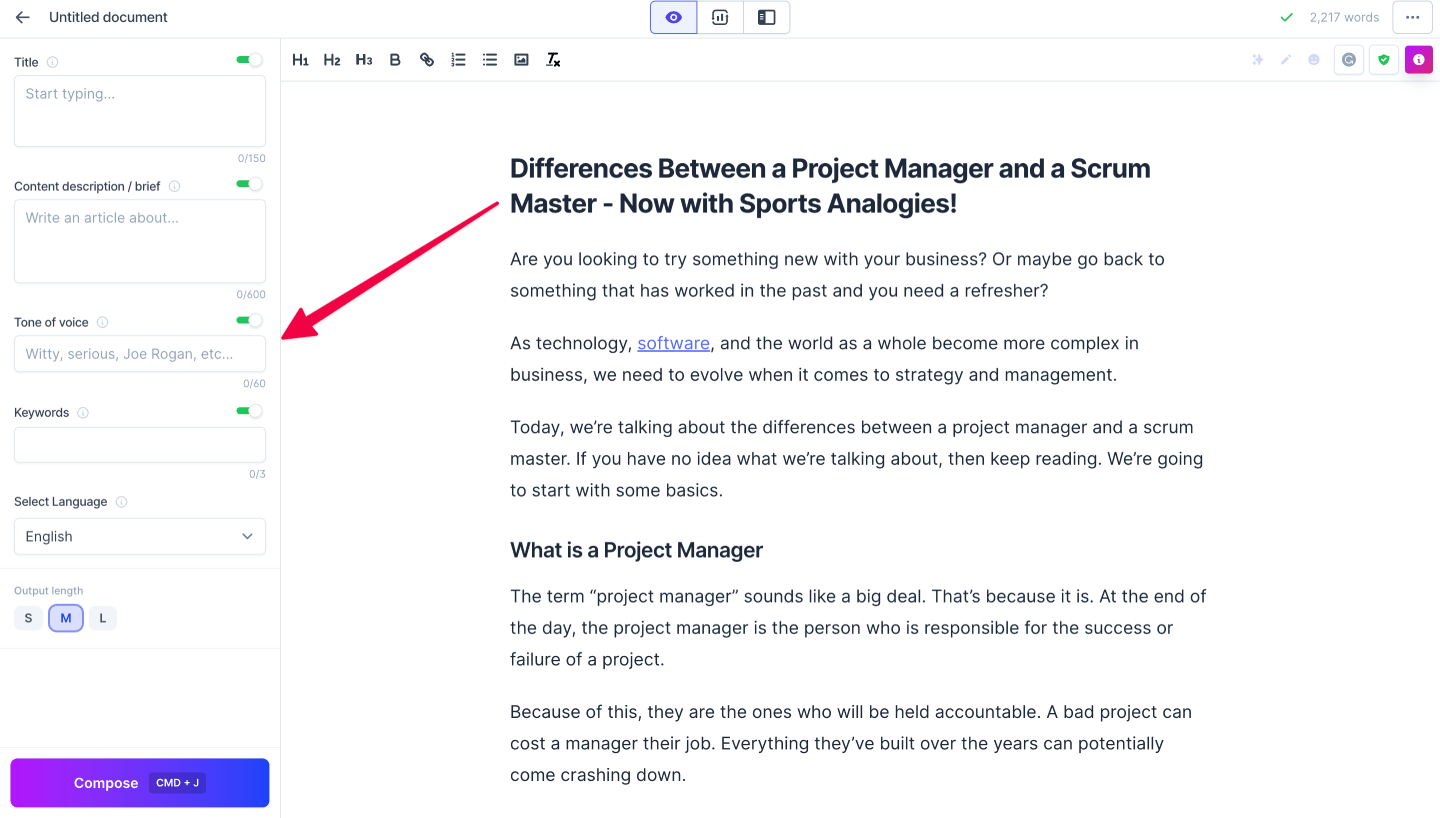
The templates and recipes also make it really easy to start outputting content right away.
And AI writing can’t get easier than just typing: >write a blog intro and getting a blog intro back for it.
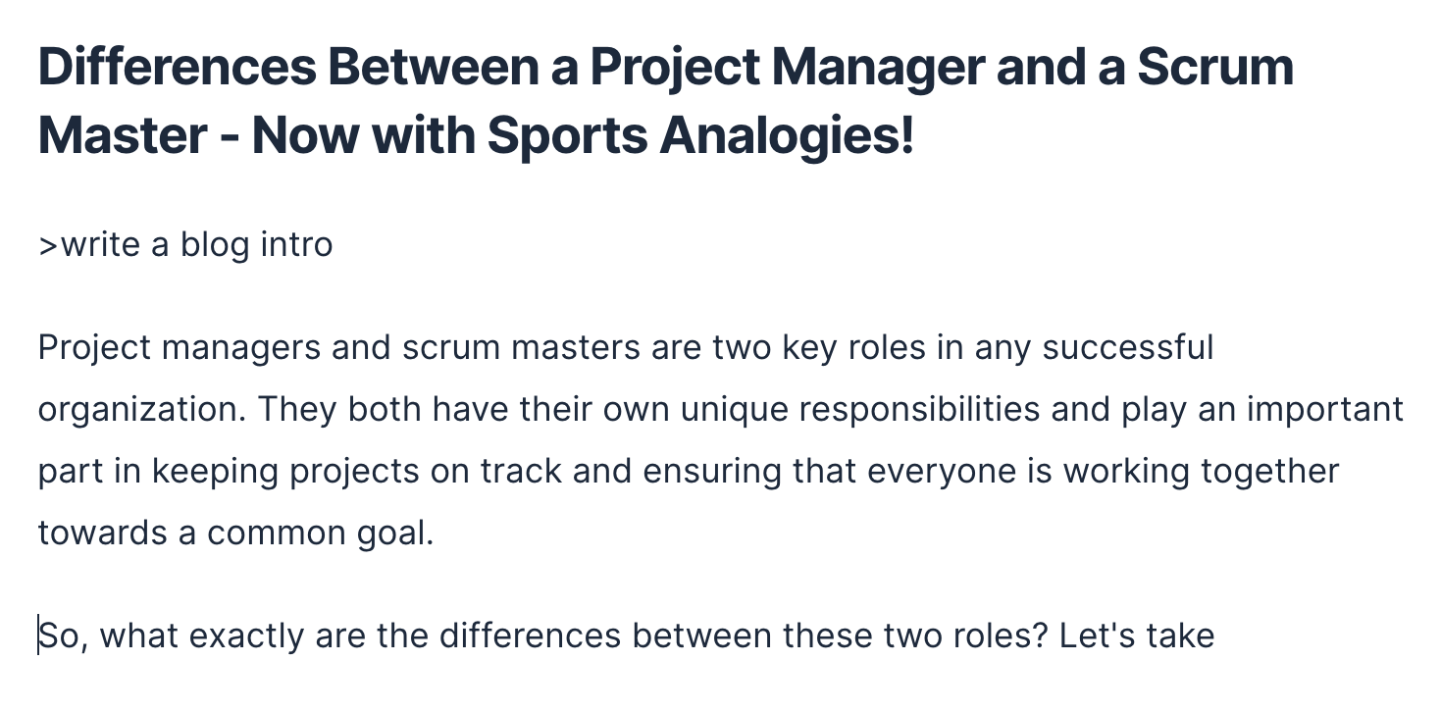
If you want something easy to use, Jasper’s the best pick.
Pricing
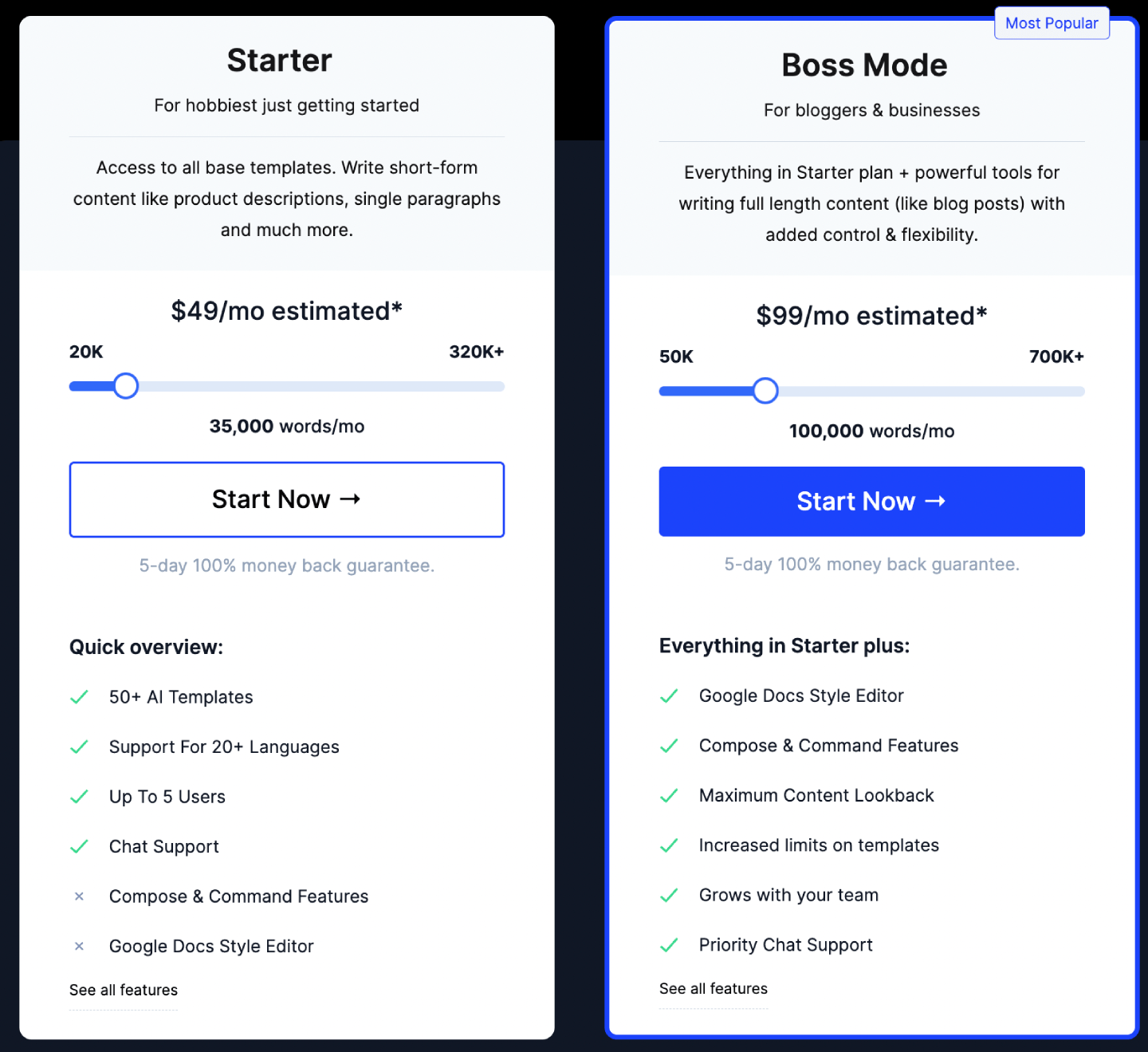
The pricing might drive some people away, though. And not just because it’s high.
Unless you get the boss mode of Jasper, you’re not getting the best AI writing software. Jasper’s cheaper plans are more of a trick to upsell you to the most expensive subscription.
Sure, $29/month sounds like a great deal.
It’s even cheaper than some of the other entries on our list. Copy AI’s cheapest paid plan is $35/month.
But if you don’t get Jasper’s Boss Mode, which starts at $59/month, you won’t get all the good stuff we praise about Jasper.
Our Experience With Jasper
We actually use Jasper in our day-to-day operations. We found it really helpful for whipping up listicles quickly.
And by quickly, I mean 30 minutes to an hour. With editing included.
We also fiddled around quite a lot with the long-form assistant.
Pssst, we have a YouTube channel, which includes a showdown between Jasper and a human writer. Give it a go:
The bottom line is this: Jasper AI is a very powerful tool if you know how to use it. Especially if you learn how to train the AI and give it advanced input.
Our Honest Take
Jasper AI is by far the best AI writing software. Sure, it outputs bad content at times. But so do most of its competitors.
And Jasper definitely makes up for it with helpful templates, recipes, easy navigation, fantastic add-ons, and the long-form assistant.
If you want to try it yourself…
You can get started with Jasper AI right now:
2 Rytr
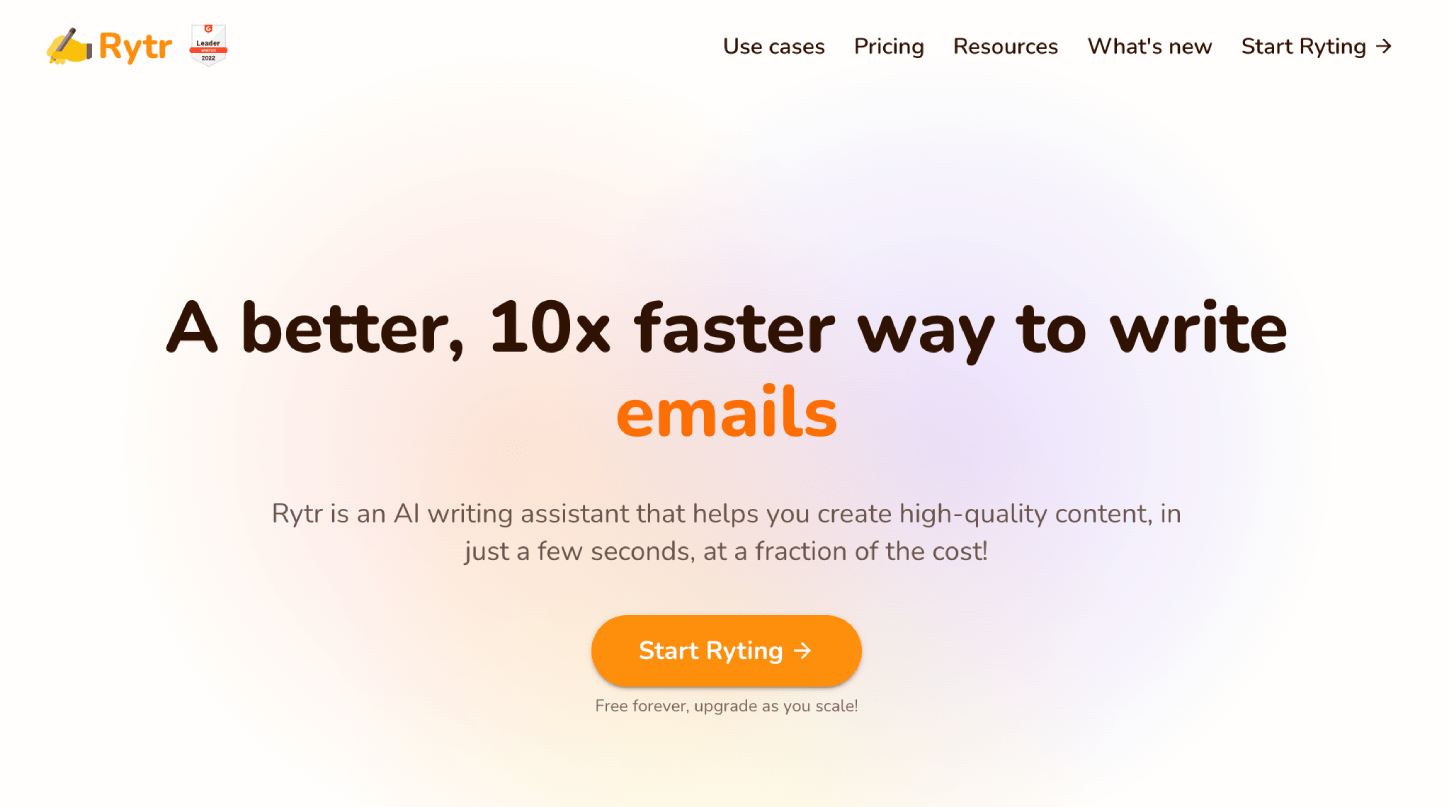
Affordable
Compact interface
Support for multiple languages, including Hindi
Output could be better
Can be confusing at first
Rytr is not as pretty as Jasper AI, Copy AI, or other competitors of theirs.
It can also be confusing when you first open it up.
If you want the best output and templates, you won’t find them here either.
Sounds like a bad pick? It’s not. Rytr is a really good affordable choice if you need AI writing software. Let’s delve deeper.
Features
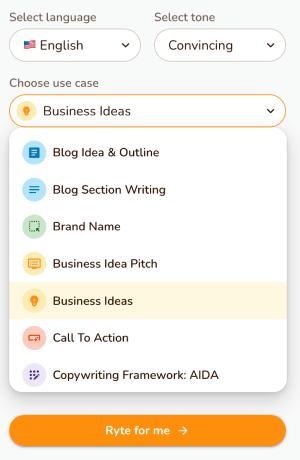
A lot of AI writing software tools limit themselves to a simple workflow:
Choose a template -> give the AI writer some input -> get AI content back in just a few seconds.
Rytr has that as well.
But it also lets you edit multiple articles, posts, emails, or any other type of document.
On top, here are Rytr’s key features:
Document editing – Rytr has the closest thing to Jasper’s long-form assistant with their on-document edits. You can select a piece of text, and use plenty of tools to rephrase it, check it for grammar, or even shorten it.
GPT-3 – Just like the best AI writing software, Rytr uses GPT-3 to power its writing software.
Over 30 use cases – Some competitors offer more, but Rytr still covers the basics.
Compact interface – Everything you can do in Rytr is concentrated in one compact dashboard.
Multi-language support – Rytr takes input, and outputs content in over 30 languages, including Hindi.
SEMRush integration – If you want help researching keywords and an AI writer in the same tool, Rytr has it.
Interface and Ease Of Use
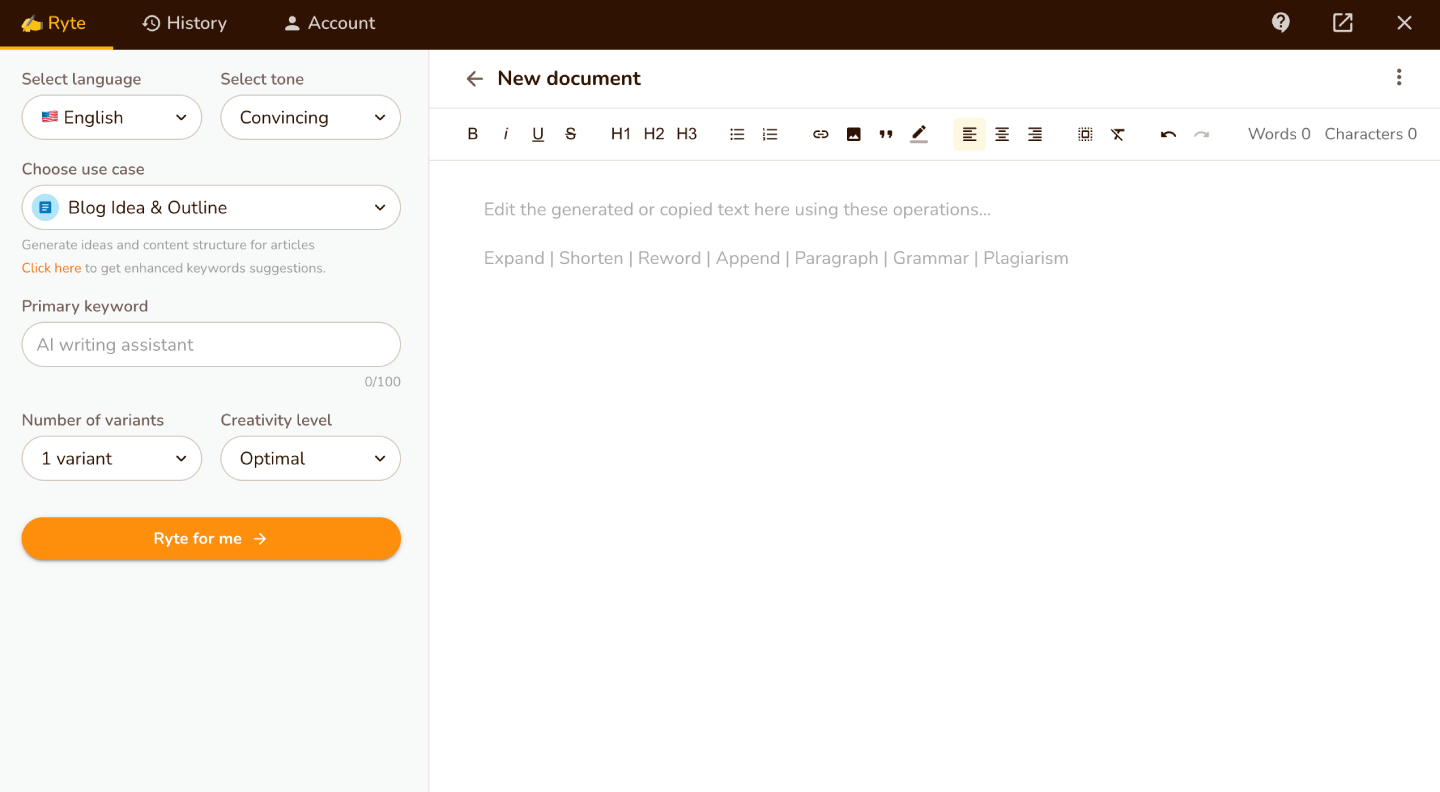
Although it can be confusing at first, Rytr’s interface is a plus when you understand how it works. That’s because it’s compact. Everything you can do in Rytr is here:
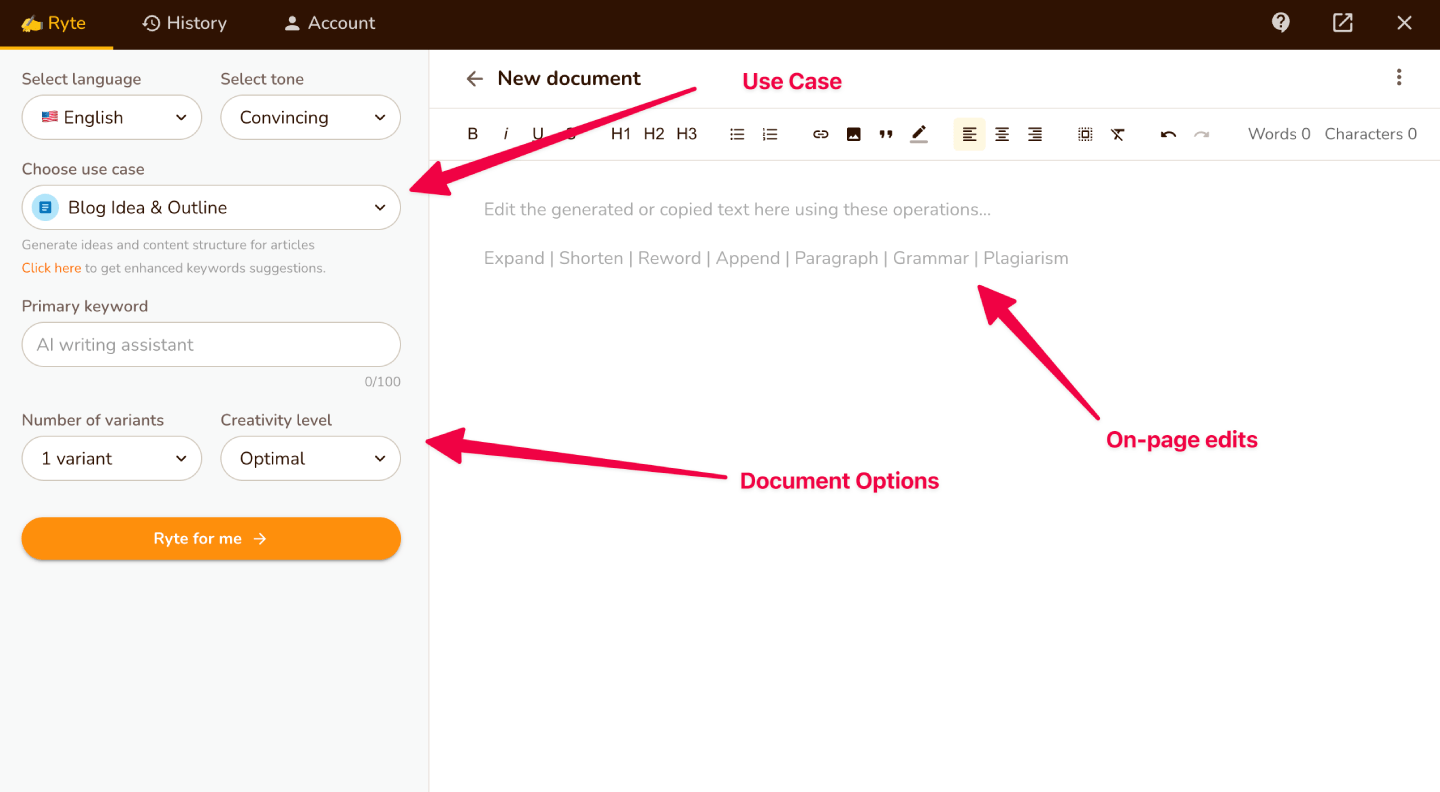
Do you want to write a blog post and an outreach email in the same document? You can use Rytr’s AI writing assistant software to do so.
Comparatively, Jasper AI, Copy AI, and every other entry on our list have multiple dashboards, windows, and tabs.
No shade to that system!
Both of them work, in my opinion.
Rytr just does things differently, and I think some of you will appreciate the integrated way of creating content in Rytr.
Pricing
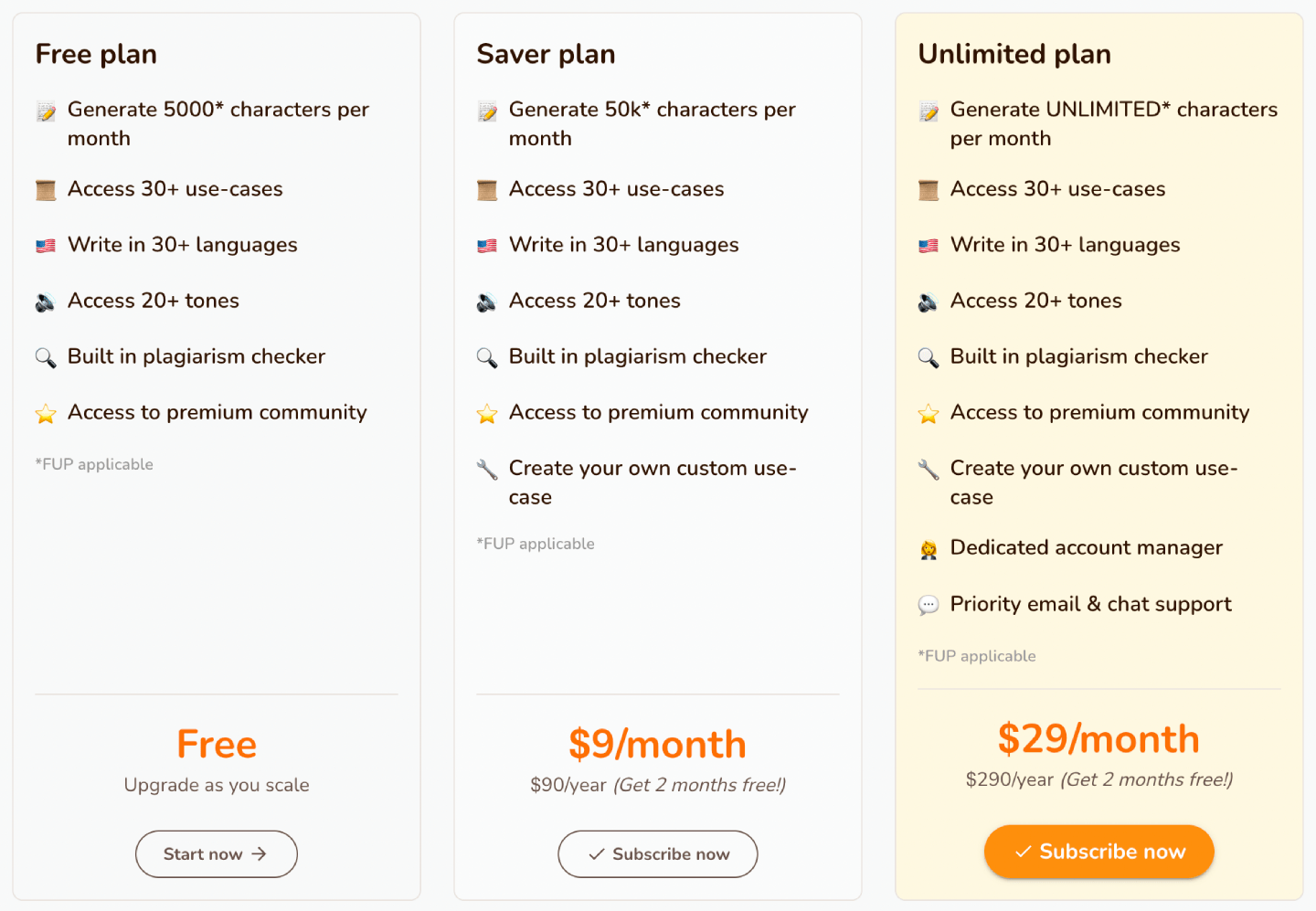
Rytr has a free plan, which is great if you want to know how it works, and whether or not you’d enjoy using Rytr.
But it’s honestly just a trial, more so than a free plan. You’ll burn through 5000 characters in no time.
The Saver Plan is really affordable, at only $9/month. But 50,000 characters is still not enough if you want to produce content in bulk.
So that’s why, if you want to make the most out of Rytr, You’ll have to buy the Unlimited Plan. And for $29/month, you’d still be paying as much as you would on Jasper’s cheapest plan.
Our Experience With Rytr
We don’t use Rytr on a daily basis at Authority Hacker. Jasper’s Boss Mode is good enough to satisfy all of our AI writing needs.
But the time we played around with Rytr, we had a lot of fun! It’s a fast and complex tool, that doesn’t sacrifice user experience to give you a lot of control over its output.
Our Honest Take
Rytr is a really good AI writing app. If you want the full package — templates, custom use cases, good output, and smart document edits — Rytr is a great option that won’t run through your savings too fast.
And if you want to write content in Hindi… this is a no-brainer.
Rytr is the only tool that supports input and output in Hindi.
And the best part?
You can get started for free right now:
3 Copy AI
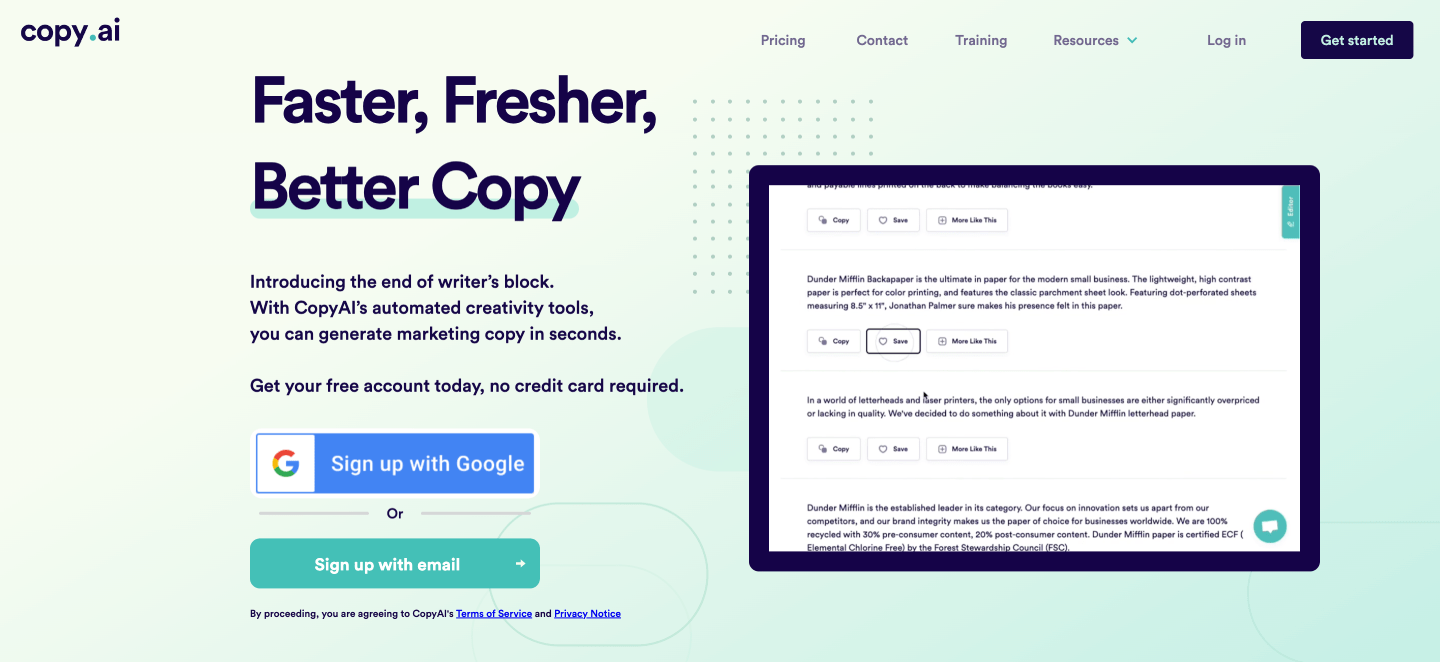
Over 90 templates
Helps with writer’s block
Good interface and user experience
Content output is a hit or miss
No long-form assistant
Copy AI is based on the same tech as Rytr and Jasper AI: GPT-3. It also has plenty of templates, editing tools, and even a grammar checker.
It’s advertised as a great way to help you overcome writer’s block, and that’s accurate. Copy AI can use machine learning to help writers create content when they’re stumped.
Features

Copy AI’s toolset doesn’t differ too much from the other tools you’ve seen so far. It’s got templates, decent output, and plenty more things you can use to create content faster and better.
If you want an overview, here are the main features of Copy AI:
Fast output – If you want a bit of content to get started writing, Copy AI will deliver that pretty fast.
GPT-3 – Like its competitors, Copy AI is based on GPT-3.
Over 90 templates – Enough to cover any content and copywriting need
Fun Templates for personal projects – I can’t promise you that they’re extremely useful, but they can help boost your inspiration.
Multi-language support – Copy AI works in over 25 languages.
Other tools and add-ons– Things like a verb booster, sentence simplifier, and grammar checker all make your content production smoother.
Interface and Ease Of Use

Some people claim Copy AI has the best interface out of all AI writing assistants. And I can see why. Copy AI is pretty, intuitive, and it’s easy to jump right into it.
The starting guide definitely helps:
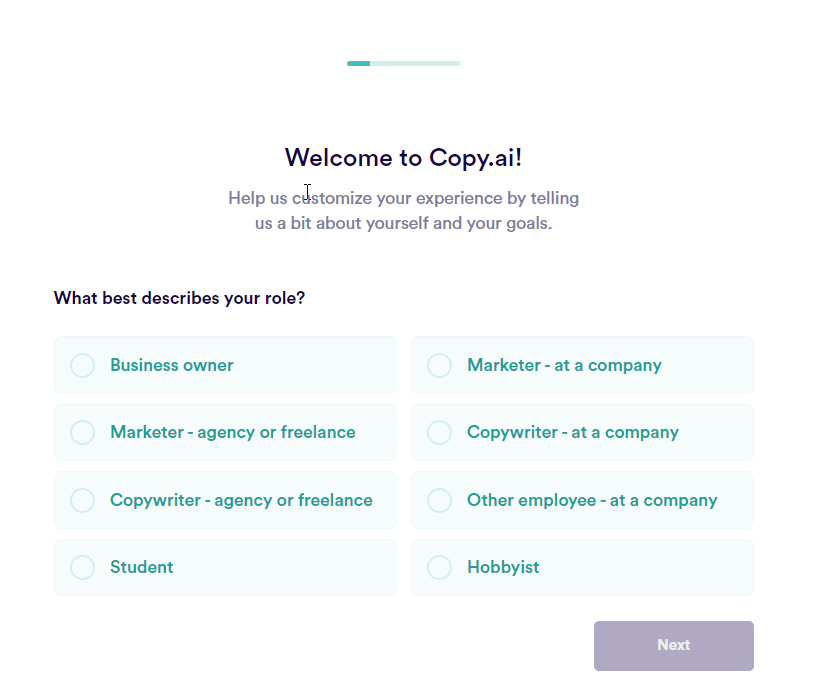
And the dashboard to fill in details for each template is very well made:
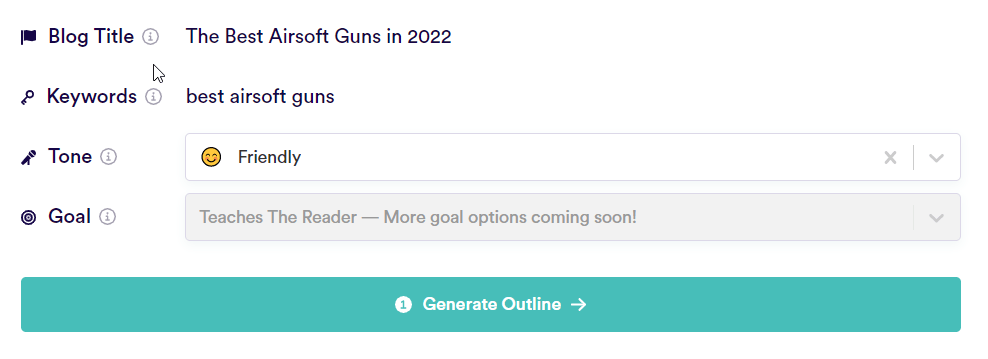
Needless to say, you won’t get confused as to which buttons do what when using Copy AI. If you want great UX, this is probably the best AI writing software for you.
Pricing

Copy AI has a free plan, which is a plus if you’re bootstrapping. But as its description says, it’s only suitable for testing. 10 credits is not a lot.
If you want to use Copy AI in your content creation, you’ll need the $35/month Pro plan.
Which is not a lot. It’s just slightly more expensive than Rytr or the lower Jasper tier.
So if you want help overcoming writer’s block, Copy AI is a great option. And you won’t break the bank with a subscription.
Our Experience With Copy AI
Let’s get one thing out of the way: Copy AI’s output is not as good as Rytr or Jasper’s. Copy AI often misses the mark on some templates, and other times it’ll just take your input, format it differently, and deliver that as “AI-generated content”.
That’s why we put Copy AI lower on our list.
But that’s not to say it’s a bad tool. Copy AI can also output high-quality content. Not to mention, it’s the only AI writing tool to support fun templates, and all of it is beautifully packaged.
Our Honest Take
Copy AI is a great pick if you want a cheaper alternative to Jasper, and you don’t like Rytr’s interface or templates. However, we can only imagine how great this tool would be with some form of long-form assistant and better output.
If you like what you saw, you can try Copy AI for free right now:
4 Writesonic

Great short-form copy templates
Long-form assistant available
Relatively affordable
Grammar issues with some output
Cluttered interface
If you write a lot of marketing copy, and you want to automate that, Writesonic might be the pick for you.
They have tons of templates for this specific purpose. You can use it to create anything from a LinkedIn description to ad copy meant for Facebook or Google.
Features
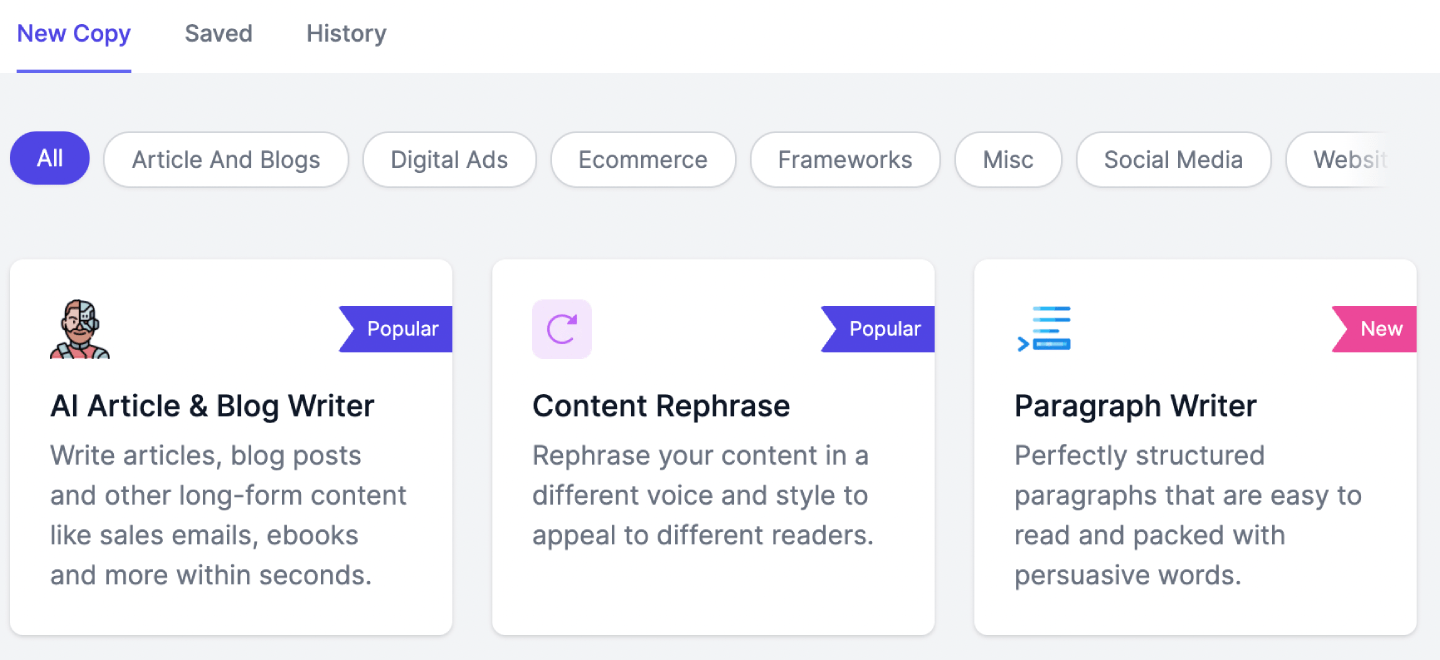
Writesonic is your average automated article writing software, at least in terms of features. It has templates to get you going, a simple process for content creation, and support for multiple languages.
More specifically, these are the main features of Writesonic:
Tons of marketing templates – Site copy, digital ads, or product descriptions, they’re all here.
Long-Form Assistant – Although it’s focused on short-form copy, Writesonic also has a long-form assistant.
GPT-3 – OpenAI’s model for AI writing seems to be everywhere. Writesonic is no exception.
Over 50 templates – They have some long-form, but most of them are focused on shorter copy.
Simple process for content creation – Just fill in some details about your copy, press “Generate”, and let Writesonic work its magic.
Multi-language support – Writesonic supports 24 languages.
Interface and Ease Of Use
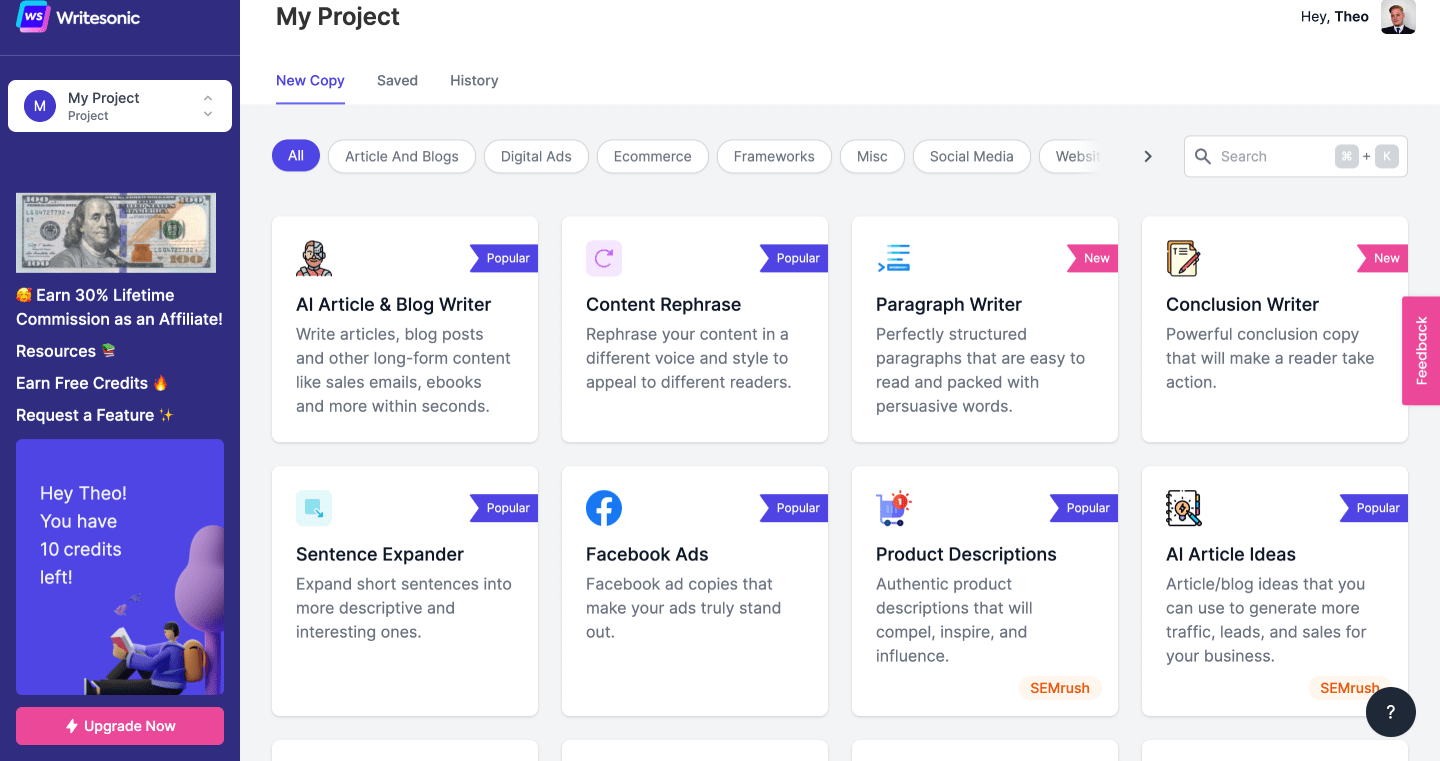
Writesonic’s interface is not bad, but it can also get pretty cluttered. As you see above, it’s not as clean as Jasper’s, or Copy AI’s.
Beyond that though, Writesonic moves fast, and its commands are pretty intuitive. Newcomers shouldn’t have a hard time getting started with it.
Pricing
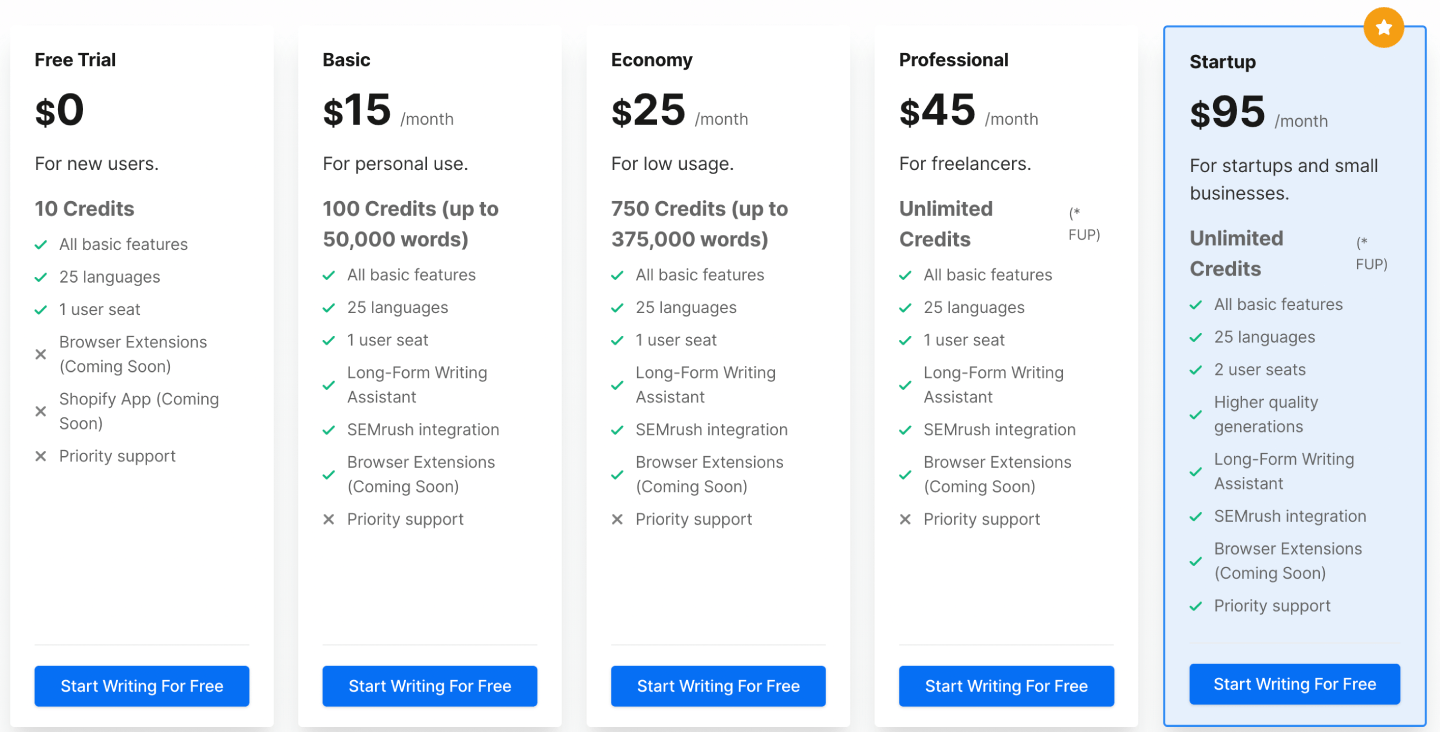
Writesonic’s pricing is pretty complex, going from free to try it out, all the way up to $95/month. What I like a lot about it is that the long-form assistant is available with a $15 subscription. Even if the credits are low, it’s great that you get strong tools with minimal investment.
By comparison, Jasper asks for $59/month if you want access to the long-form assistant.
But if we’re fair, you need unlimited credits to make the most out of Writesonic’s toolset. That’s why we recommend you at least invest in the Professional subscription ($45/month).
Conclusion
Writesonic is a good pick if you want to use AI to generate short-form marketing copy in bulk. Its unlimited credits plan is affordable, and it comes with a long-form assistant. Not to mention, all the templates it has are enough to help with any digital copy demand.
Try Writesonic for free today:
5 ContentBox.AI

Great content optimization tools
Basic tools for AI content generation
Browser extensions
Pricey
Barebones AI generation suite
Very few templates
ContentBox.AI is not as complex as other entries on this list. It doesn’t have support for dozens of languages, or tons of extras. But it can output decent content, and it’s really good at content optimization with the help of AI.
Features
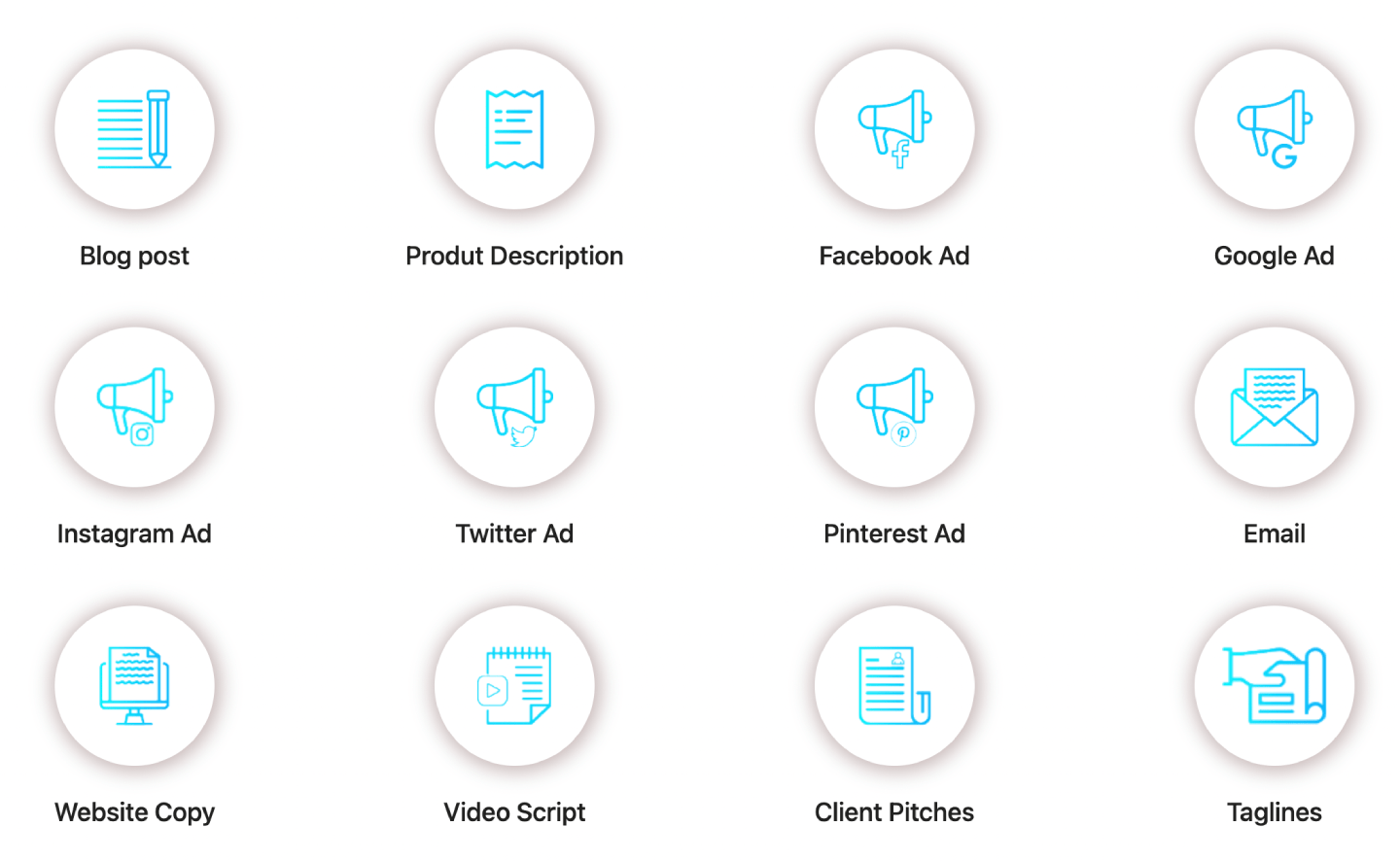
ContentBox uses natural language processing to optimize your content. And that’s one of the reasons people sign-up for a ContentBox subscription.
On top, here are its main features:
Content Optimization Tools – Autocomplete, text expander, and a summarizer all help you augment your copy.
Browser Extensions – Perfect to optimize your content wherever you work.
Over 12 templates – Not the most templates on the planet, but enough to get you started.
Simple process for content creation – You can use these templates to whip up content in a matter of minutes.
Multi-language support – ContentBox supports 11 languages.
Interface and Ease Of Use
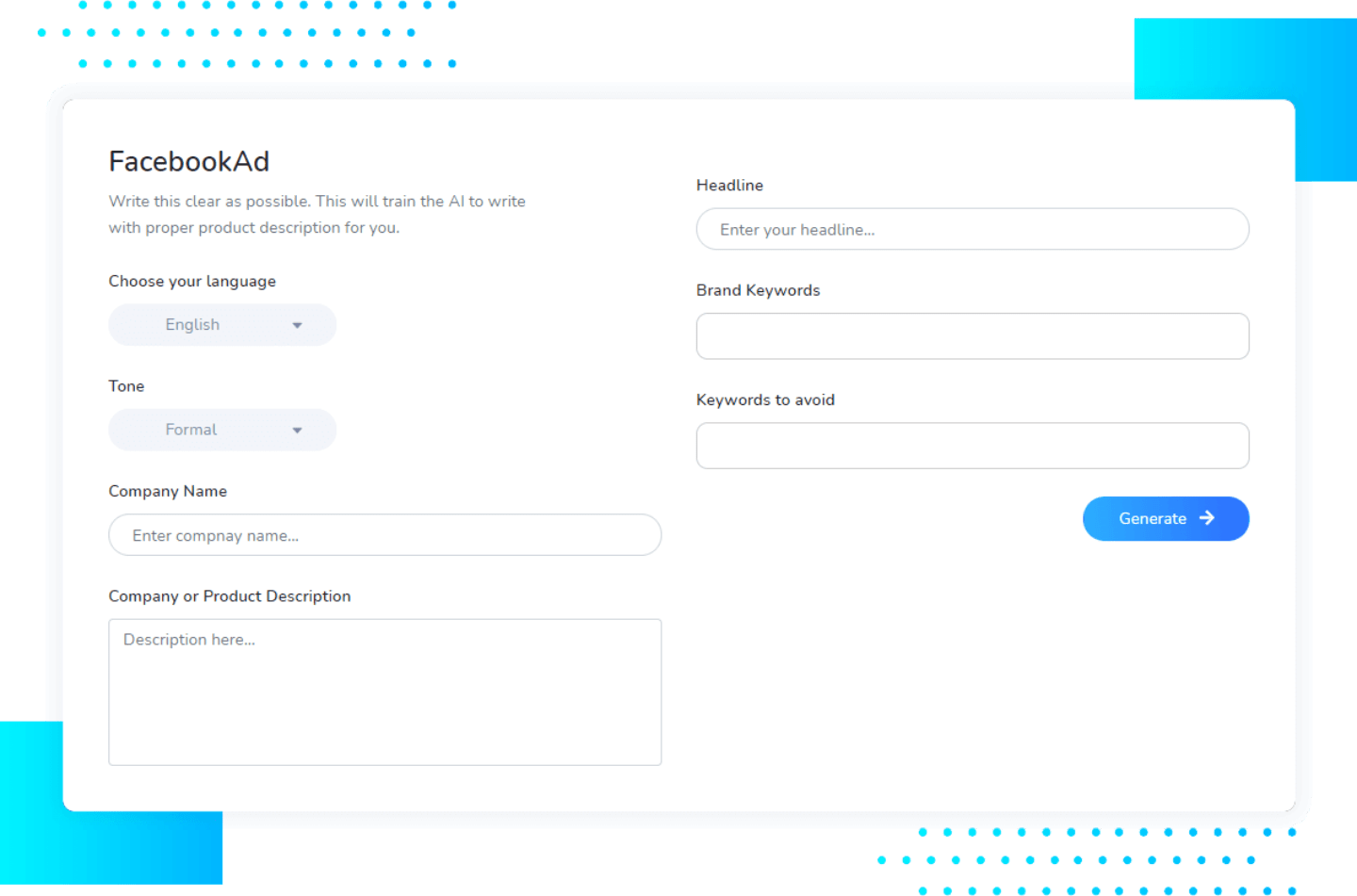
Contentbox AI is very straightforward. Once you’re in the web app, you can choose a template, fill in some input, and generate AI content based on that.
All of it is in a well designed interface.
The browser extensions also make it really easy to optimize any type of content, with minimal set-up. So all in all, ContentBox AI is easy to use.
Pricing
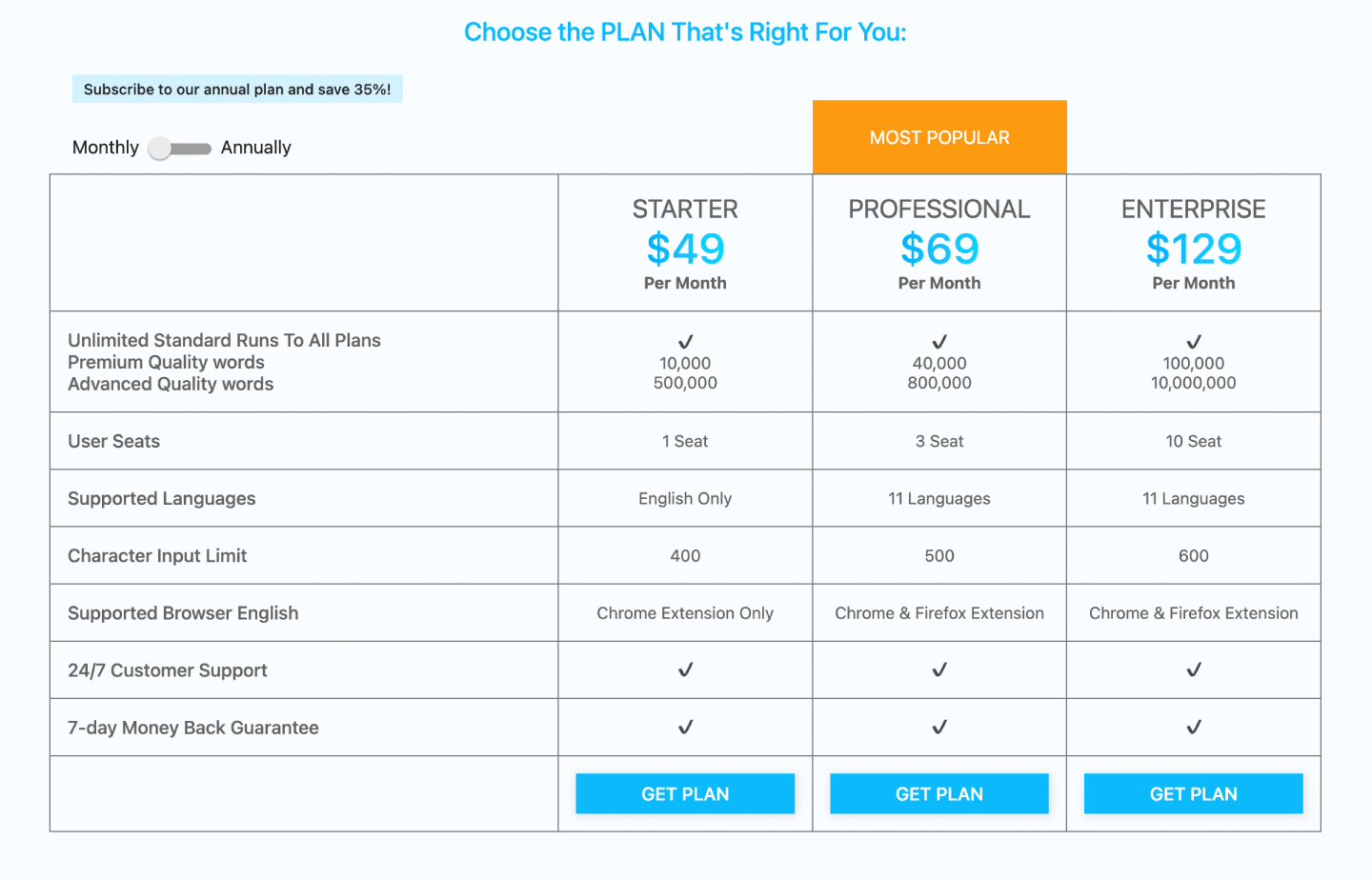
ContentBoxAI is a bit more expensive than the market average. The cheapest plan is $49/month, but it’s pretty barebones. The core functionality is there, yet you only get 500 characters to input data about your content, support for just one language, and a 10,000 words cap.
If you want to use ContentBox to its full extent, you’ll need at least the Professional plan, which is $69/month. It comes with support for 11 languages, a 40,000 words cap, and 500 characters for your input.
You also get a 7-day money-back guarantee on all plans, perfect if you just want to try it out for a little bit.
Conclusion
ContentBox AI has the basic tools you need to generate AI content. Some templates, support for user input, multiple languages to write in. But nothing too fancy.
ContentBox stands out thanks to its convenient content optimization tools. Just sign-up, install the Chrome extension, and you’re good to go.
Try ContentBox.AI for $49/month today:
6 Frase IO

Great research tools
All-in-one content creation suite
Helpful content optimization features
A bit expensive
Interface can get confusing
Tries to do too much at once
Frase IO won’t astound anyone with its AI content generation. But it does bring more to the table: topic research, SERP analysis, and a deep dive into what people are asking about a specific keyword.
So let’s see what it can do.
Features
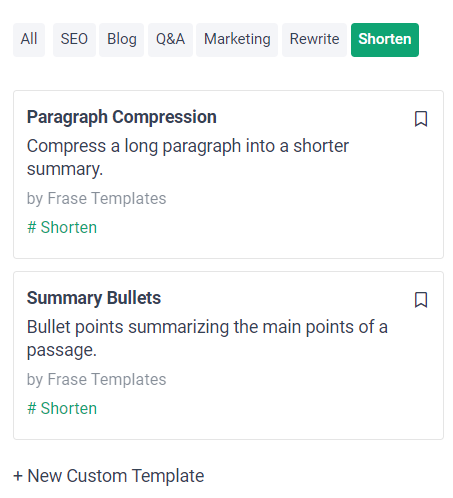
Frase IO is a special mix of a tool. Not just an AI writing software, and not just a research tool. It combines everything site owners need to output content faster.
Here are Frase IO’s main features:
In-dept research – Frase IO takes your keyword, and delivers topic, SERP, and community research on it.
Content Optimization – Like Surfer SEO, Frase suggests keywords to use in each document.
Over 10 Content Templates – Frase IO doesn’t rely too much on these, but they’re helpful to get you started.
Decent AI writing software – It’s not based on GPT-3, so results may vary. But it can do a good job sometimes.
Fully fleshed document editor – Including SEO checker, grammar corrections, and a rudimentary task management system.
Interface and Ease Of Use

Frase Io is much more complex than any other tool we’ve explored so far. And that can sometimes lead to confusion as to where to find some features.
For example, once you’re in the document editor, it’s cumbersome to get back to the research tab.
But with all of these issues, Frase IO manages to stay somewhat user-friendly. If you give it a few hours, you’ll know exactly where everything is, and how to make the most of it.
The starting guide also helps a lot:
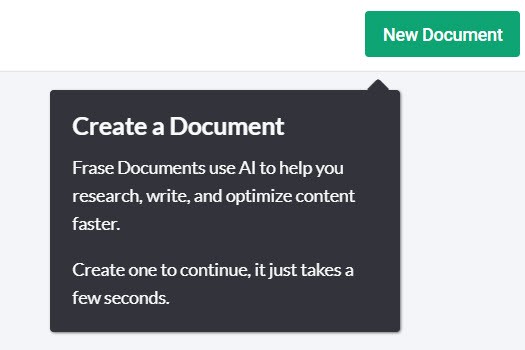
It’s not on par with Jasper, Copy AI, or Surfer SEO. But it’s still easy enough to use so it doesn’t become a downside.
Pricing

Frase IO has a complex pricing scheme. The cheapest you can get it for is $39.99/month, and it goes up to $114.99/month. However, that’s the price for just the research tools of Frase IO.
If you want the SEO Add-on, which includes content generation and content optimization, you’ll have to pay an extra $35/month.
Which brings the total to $75-$80/month. That’s what you’ll have to pay if you want to make the most out of Frase IO. It’s more expensive than your average AI writing tool, but on-par with the market when compared to other tools that also offer research features.
Our Experience With Frase IO
Frase IO is not perfect. We loved its research tools, which really give you an in-depth understanding of a topic. But in our experience, its content generator can miss the mark sometimes.
The content optimization tools are decent. But we’ve had much more success with Surfer SEO. And it’s much easier to use.
Our Honest Take
Frase IO tries to do a lot of things at once. Research, AI content generation, content optimization, and even task management. It gets some of these things right. Especially the research.
But for all the other ones, there are better tools out there. Tools that solve one specific problem.
If you want them all in one place though, you can get started with $44.99/month right now:
7 GrowthBar

Basic keyword and competitor research
Useful content optimization tools
Pretty affordable
Barebones SEO features
AI writing assistant is a hit or miss
GrowthBar is an AI assistant focused on SEO.
It has the average tools to help you write content, metadata, etc.
But on top of that, GrowthBar boasts many features that help you research keywords, competitors, topics, and other crucial information for SEO.
Features

Growthbar has everything you need to research a keyword and your SERP competition, and then generate content to outrank them.
Here’s what it can do:
Keyword research tool – Get information like monthly searches or ranking difficulty.
Keyword ranking tool – Lets you keep track of how your articles are performing.
Competitor research – You can use Growthbar to keep tabs on your SERP competitors.
AI Writing Tool – With the help of GPT-3, Growthbar can generate content for you.
Content optimization tools – Helps you pick the right keywords and structure for your posts.
Responsive document editor– You can even add images straight to Growthbar.
Interface and Ease Of Use
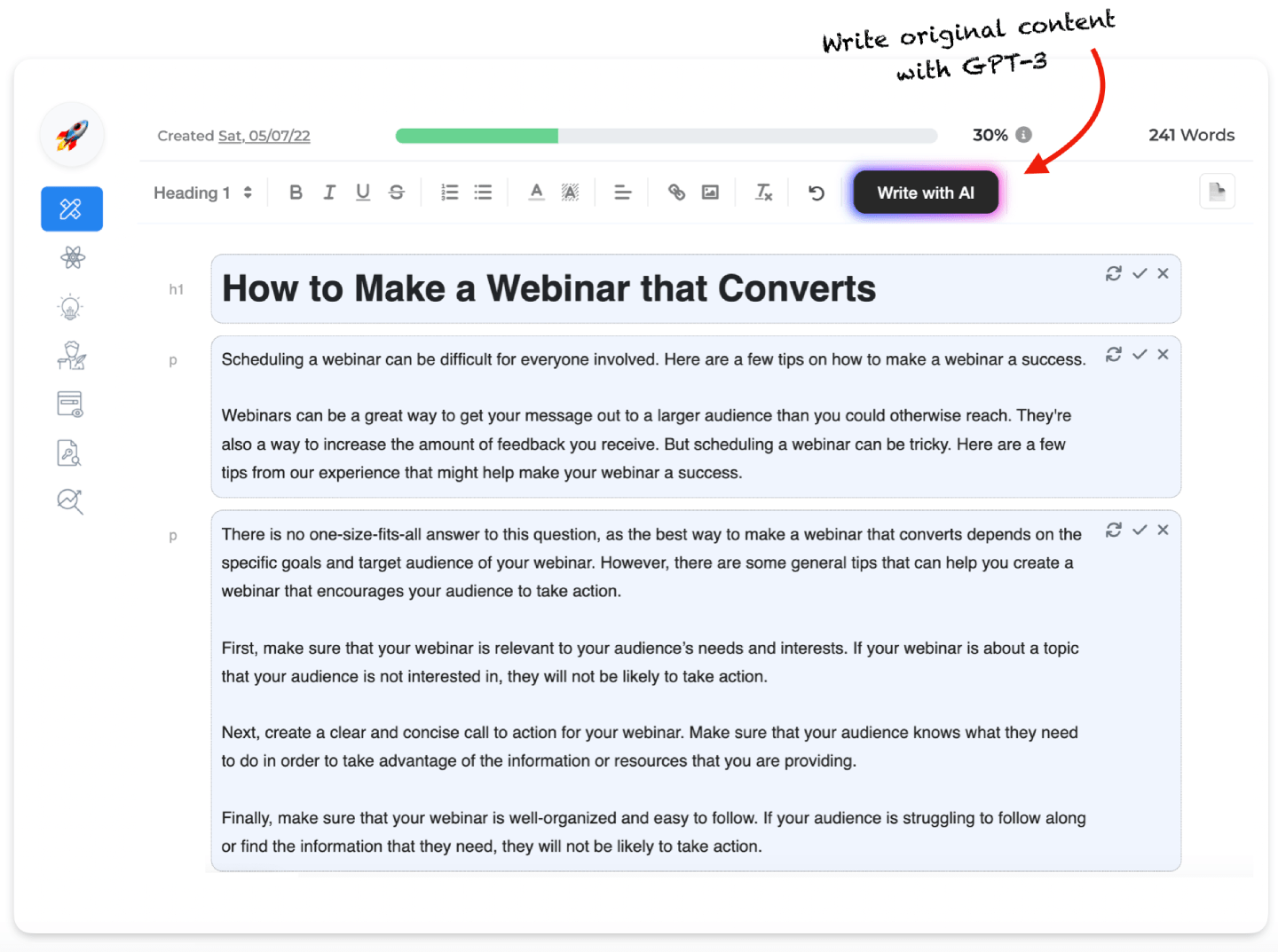
Growthbar has an intuitive and smooth interface. It’s a pleasure to work in the tool, and you always know where to go if you need to use a feature. Considering how stacked its toolset is, this is an impressive achievement.
This applies to all of its dashboards and suites – whether you need keyword research, or AI writing, you can access it easily.
Pricing
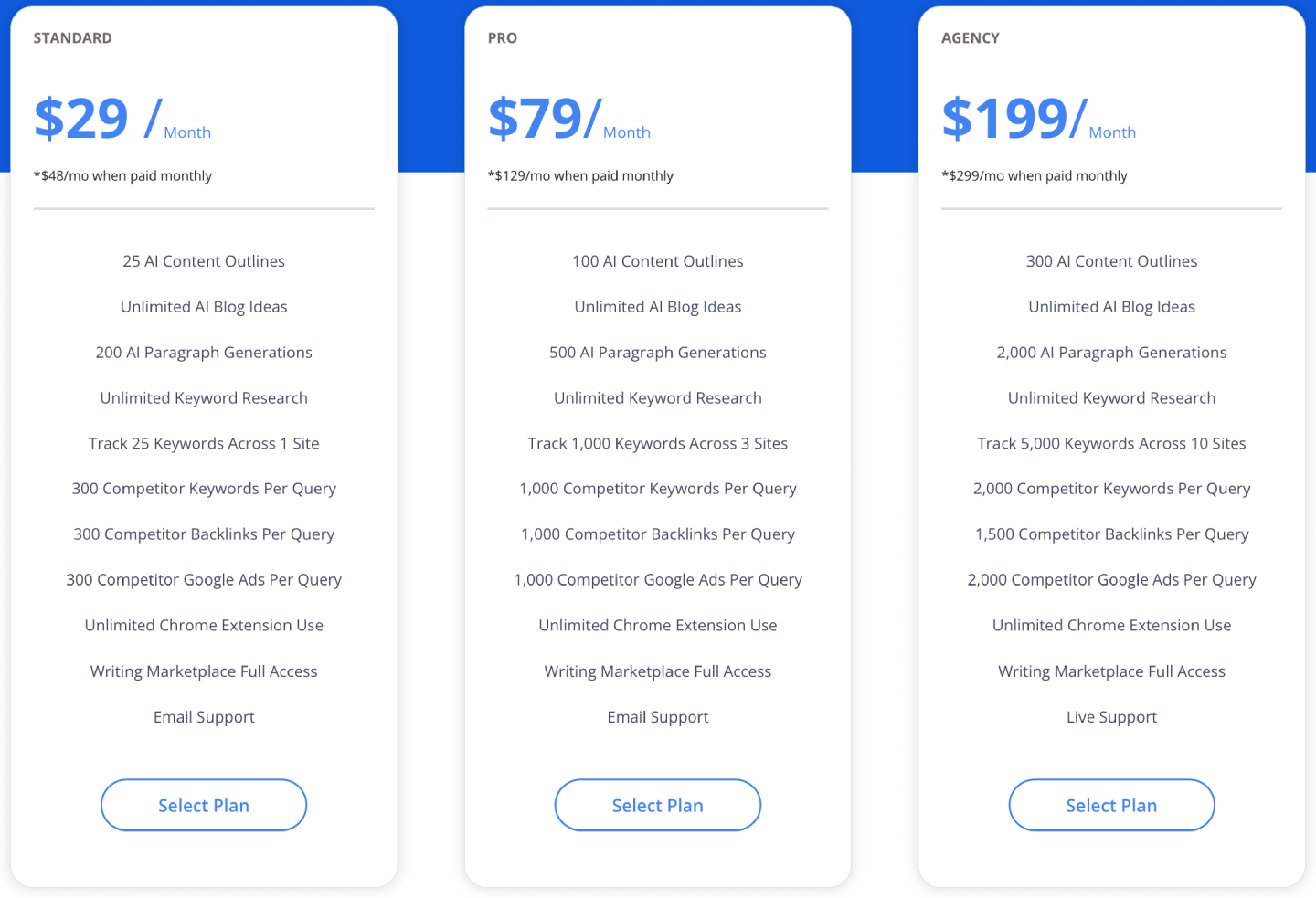
Growthbar has one of the best pricing schemes in this niche. Its cheapest plan, which only costs $48/month ($29 when paid for a full year), gives you access to all the tools Growthbar can boast with.
The only reason you’d upgrade is if you need more than the 25-articles limit in the cheapest plan.
But honestly, that’s not a bad limit. You can get a lot done with 25 articles per month.
Conclusion
Growthbar overlaps in functionality with a lot of behemoths in the online world. We wouldn’t use its keyword and competitor research features, since we already use Ahrefs. We wouldn’t use its content optimization features, since we already use Surfer SEO.
Not to mention, the SEO features are pretty slimmed down in terms of functionality.
But if you want a tool that does all of them (to differing degrees of success), and AI writing on top, you can try Growthbar today:
8 Article Forge

Very affordable
Good for bulk content generation
Innovative features to improve the editing workflow
AI content is not top-notch all the time
Can take a while to generate content
Article Forge is another AI writing tool focused on SEO. And it can be helpful if you need help with multiple languages and if you want to generate content in bulk.
Features

Article Forge wants to cut down on your AI content editing time by helping you generate content in bulk, and offering some innovative extra perks.
In short, these are its main features:
AI Content Generation – Get content in bulk in a matter of minutes.
Tons of SEO automations – With Article Forge, you can automatically create and post something straight into WordPress.
Enhance your content – Article Forge adds links, images, and even LSI keywords to your articles.
Multi Language Support – Article Forge works in 7 languages.
SEO Integrations – Use Word.AI, SEO Autopilot, RankerX, and plenty other integrations to power-up your content creation.
Interface and Ease Of Use
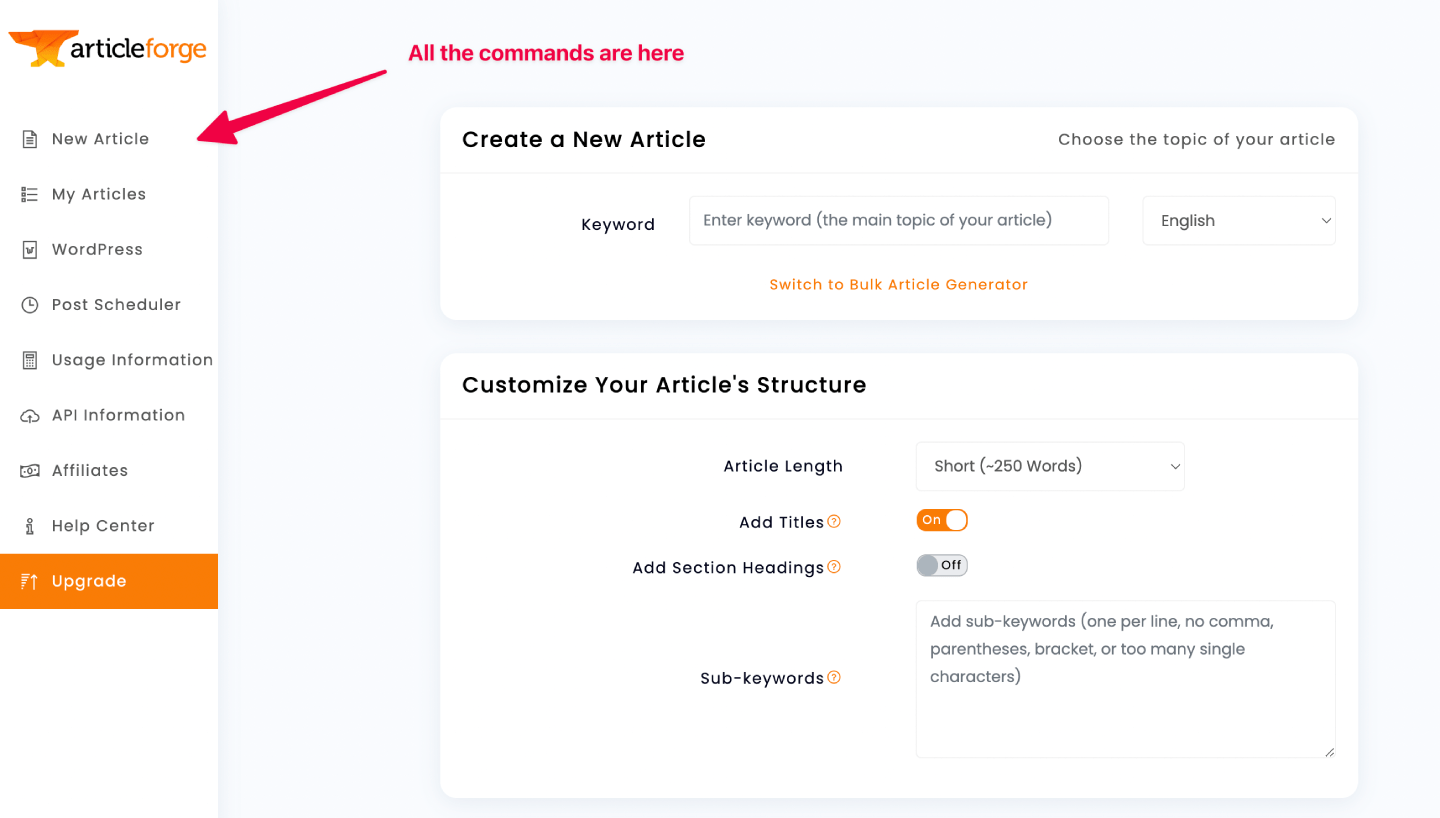
Article Forge can do a lot. So its very lightweight and easy to use interface is a huge perk in our book. Anything you can do in it is available from a simple tab on the left side of the screen.
As you can see from the screenshot, the options you get in each window of Article Forge aren’t too overwhelming, so anyone can get started with this AI writing assistant in no time.
Pricing

Article Forge is on the cheap side of AI writing assistants. The cheapest you can get this tool is $13/month, if you pay for a full year in advance. And that’s for 40,000 words per month, which is pretty decent.
Even if you want unlimited words, you’ll only be paying $57/month. By comparison, Jasper AI’s $59/month plan caps you at 50,000 words.
Conclusion
Article Forge is an affordable AI content generator, and SEO researcher. When you draw the line, it actually has one of the most comprehensive tool stacks, for one of the cheapest price tags in the whole market.
If you’re bootstrapping and you want some help putting out content faster, Article Forge is probably a smart pick. And you can get a free trial today:
Just remember that Google isn’t super friendly towards AI-written content.
9 PepperType AI

Quick output
Lightweight tool
Plenty of templates
No special features
Grammar isn’t its forte
If you don’t want to wait minutes on end for content to generate, and you don’t want to dig too deep in your pockets, PepperType AI might be the solution you’re looking for.
It’s a pretty simple AI content writer, but it’s focused on speed in delivery.
Features
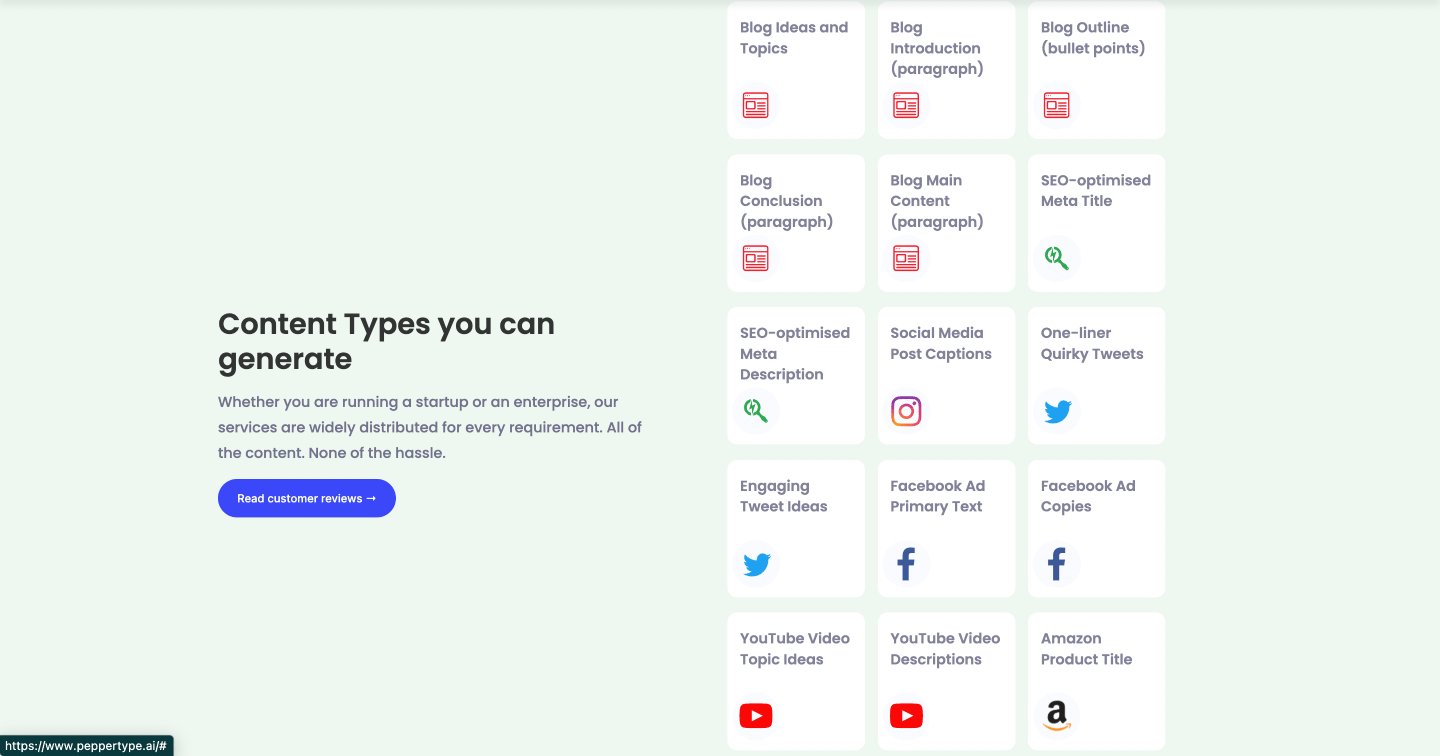
PepperType AI seems pretty slim from the outside. Just your average AI writing tool, right?
Not really. PepperType has A LOT of helpful templates, a strong content generation suite, and plenty more on top. It’s also trusted by big brands like Facebook, Amazon, or Adobe.
If you want a rundown of its features, here they are:
Quick AI Content Generation– Generate AI content as fast as current technology can.
Over 30 templates – PepperType has plenty of pre-made templates to help you kickstart content production.
Simple process for Ai writing – PepperType AI can write for you in just 3 steps.
Lightweight toolset- Not too advanced, but that makes PepperType very easy to operate.
Interface and Ease Of Use
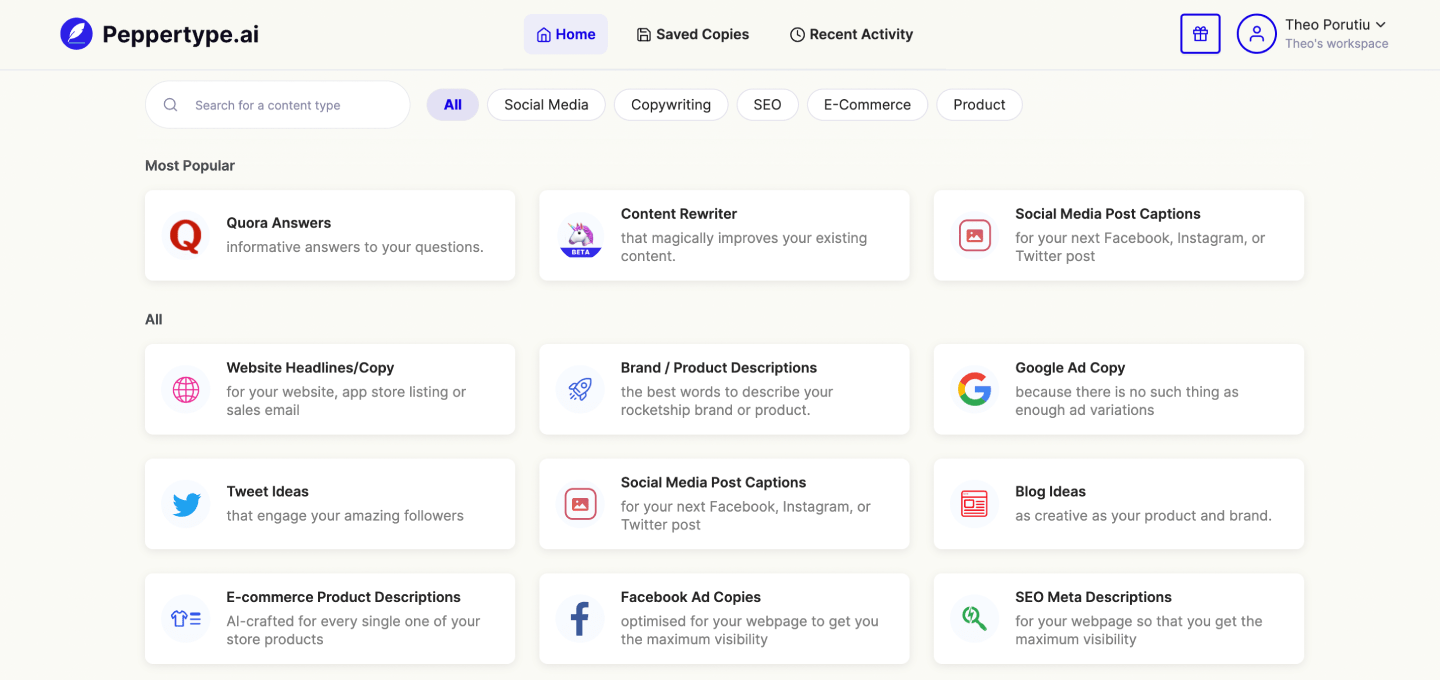
PepperType has the template AI writing design. A dashboard to oversee your work, a dashboard for templates, and a window to fill in details about the content you need.
It’s all pretty straightforward. And the content production workflow is seamless, so PepperType AI is overall well-designed, and easy to use.
Pricing

PepperType’s pricing is slightly below the market average. At least for the Starter Plan. It only costs $25/month, and it includes everything PepperType can do to speed up your content production.
If you want coworking tools, you’ll have to pay $165/month for their Growth plan.
But all of these price points can change based on how many user seats you need. For example, you can get the Starter plan, but for two users, and it’ll cost you $50/month.
All of the user seats come with their own 50,000 words cap.
Conclusion
If you like Jasper’s speed, but don’t want to spend a hundred bucks a month to get started, PepperType AI is probably the best alternative. It’s lightning fast, it’s affordable, and it has an impressive amount of templates.
And if you click on the button below, you can get started for free:
10 Anyword
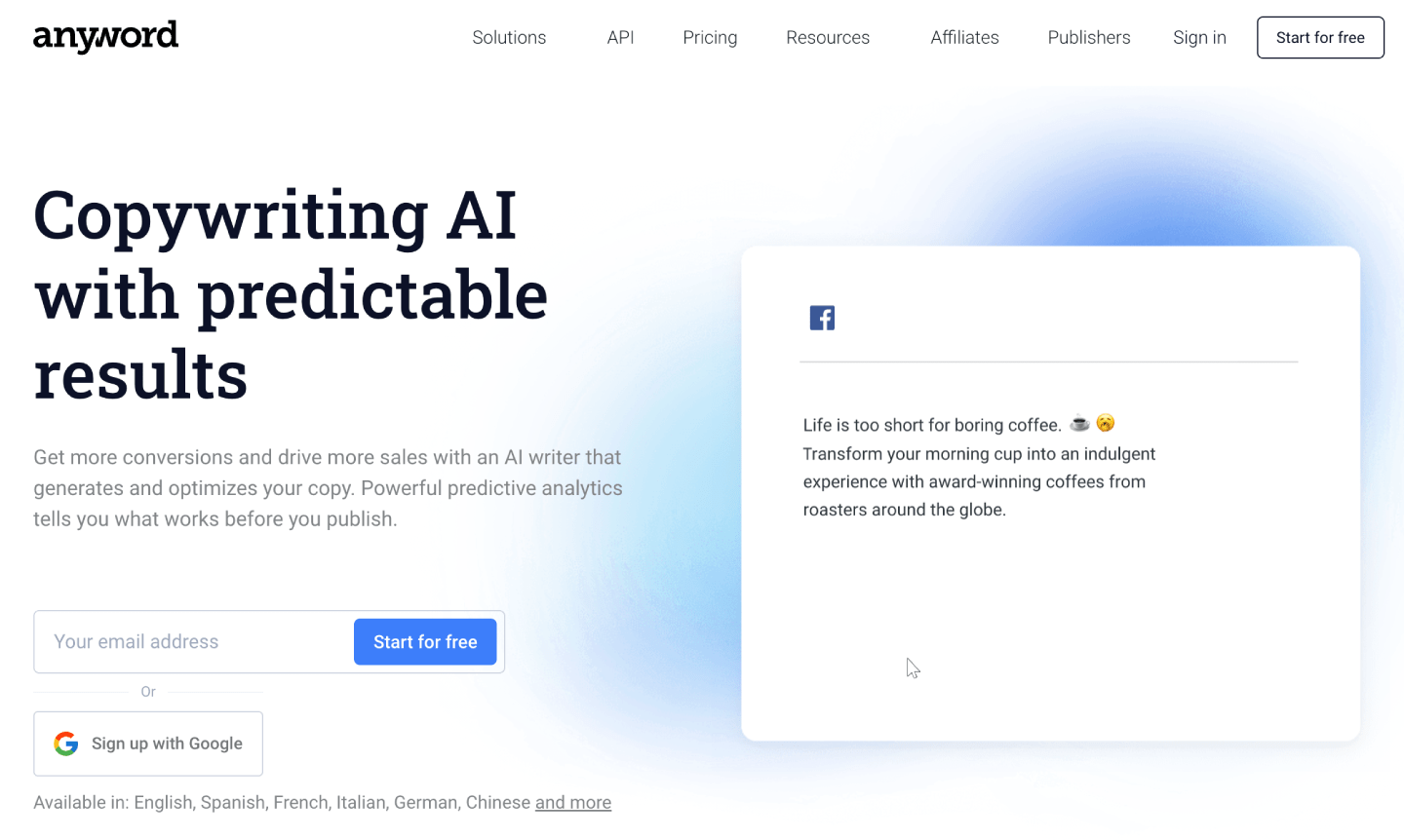
Special features to engage your audience
Clean and fast interface
Easy to use
Pretty expensive
All the cool features are very pricey
Struggling to connect with your target audience? Anyword might help.
It’s an AI writing software with all the usual bells and whistles — templates, multi-language support, etc. But it takes it a step further: dedicated support for engaging an audience with its AI-generated content.
Let’s see how it works.
Features
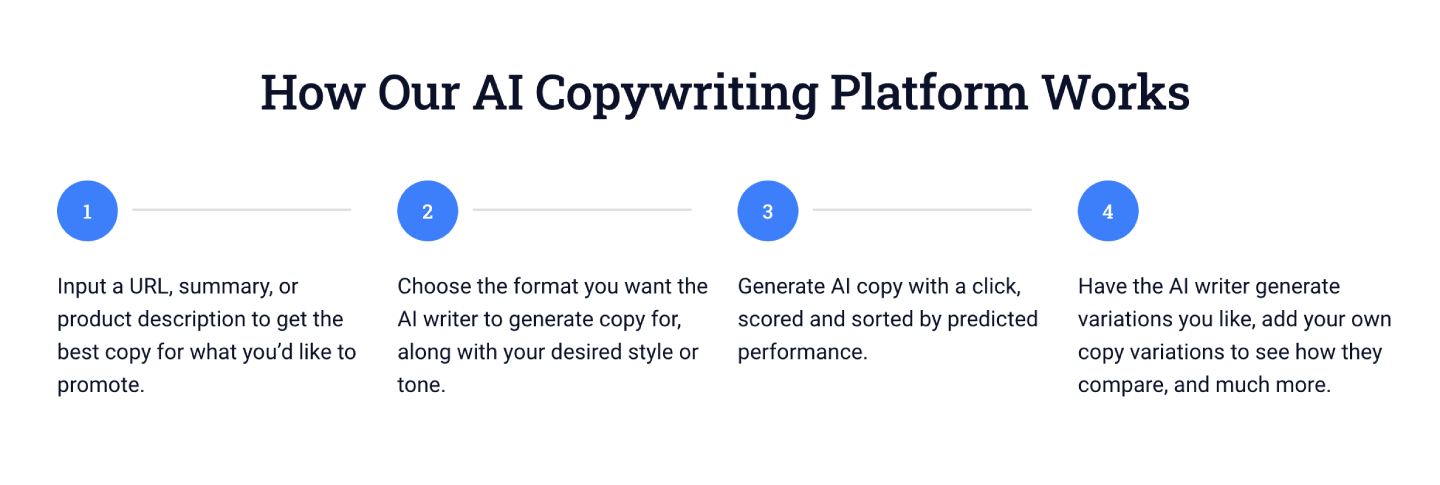
Anyword helps you generate AI content, all while keeping a specific audience in mind. Whether you’re targeting Gen Z gamers, or potential cruise ship passengers, it’s supposedly able to adapt.
How can it do that? Here are Anyword’s main features:
Audience Engagement Score – Anyword scores your content based on how likely it is to engage an audience.
Customer profiles – These let you target specific audience with your AI-generated copy.
Great support for content templates – You can create your own, or use one from Anyword.
Optimize content on-site – You can use Anyword’s API to continuously optimize content on your site.
Conversion-driven approach – Everything in Anyword is made to help you sell more.
Interface and Ease Of Use

Anyword’s interface is pretty clean. It can do a lot, so it’s really helpful that you can catch onto what each dashboard does.
Not to mention, you get a guide to get started by creating your first blog post in Anyword:

You can hit the ground running with this AI writing software.
Pricing
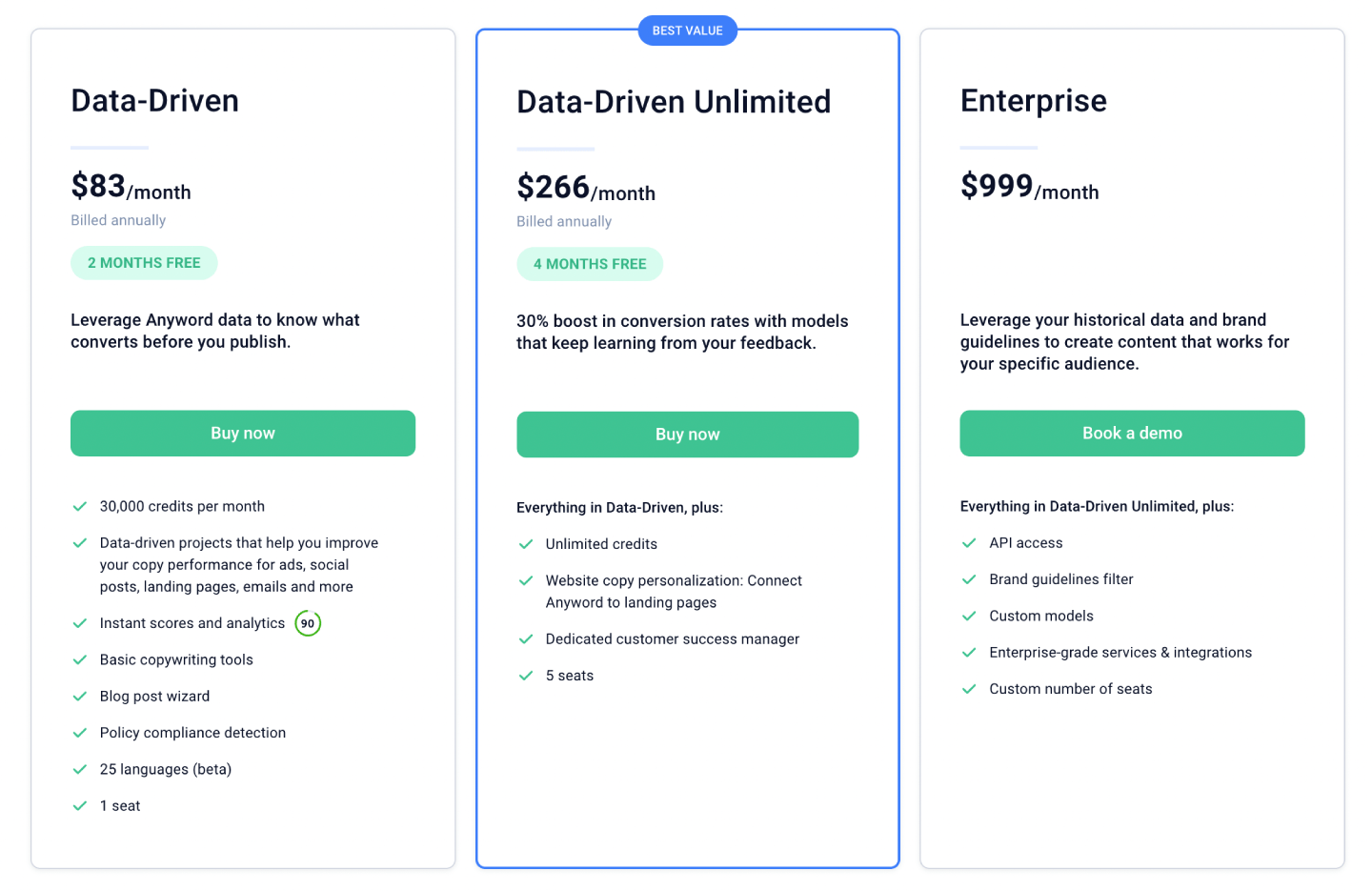
Anyword is a strong pick if you need an AI writer that helps you convert more. But that won’t come cheap. The lowest subscription tier for Anyword will set you back $83/month, while the most expensive plan is $999/month.
What hurts most is that some of the coolest features of Anyword, like its integration with your landing pages, are only available for $266/month.
So Anyword isn’t the right pick if you’re bootstrapping. It requires a serious investment.
Conclusion
Anyword is a very special AI writing tool. It won’t aimlessly generate content, but rather ground it in what your specific audience wants to see. So it can work wonders for your sales, but that won’t be cheap.
If you can afford it, it’s a smart investment. And with our link, you can get started for free:
11 Outranking.io
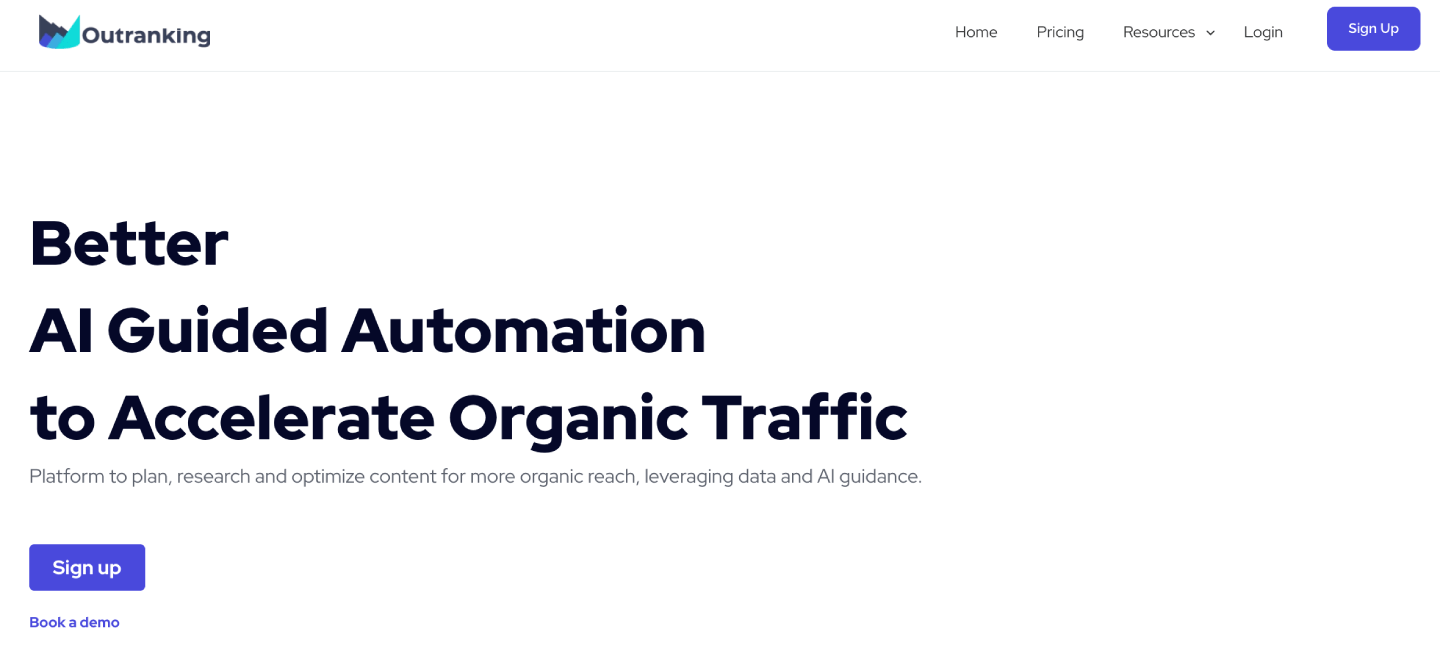
Topic and keyword research
Content optimizer
Data-driven approach
Not the best AI writer
The interface can get cluttered
(don’t confuse it with Outranking.com, which is an SEO agency)
Outranking has a data-driven approach to generating AI content.
It does this with a clear workflow that takes you through SERP analysis, SEO scoring, and AI writing assistance.
Features
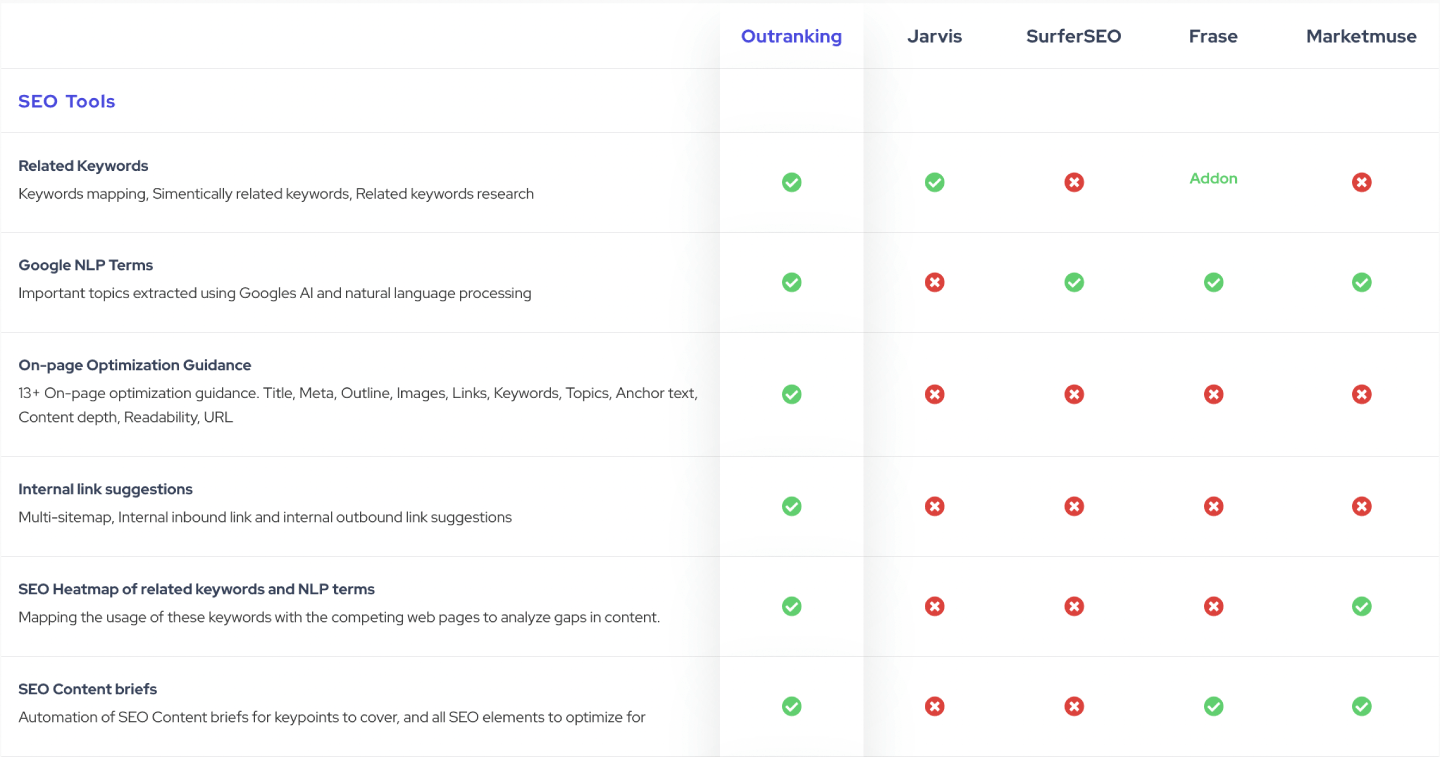
In many ways, Outranking.io is very similar to Frase IO. It researches a topic and then creates an article for you step-by-step.
After this process, you can also optimize the content.
Here’s how you do all of it in Outranking.io:
Topic Research – Outranking.io takes your keyword, and analyzes an ideal structure for your article, what people are talking about on that topic, and plenty more.
Content Brief Generation – Based on that research, Outranking creates a content brief for your article.
AI writing – Outranking.io can use AI to generate content based on the brief.
Optimize content on-page – A quick and easy way to improve your content.
Default to data – Outranking helps you generate and improve your content with a data-driven approach.
Interface and Ease Of Use
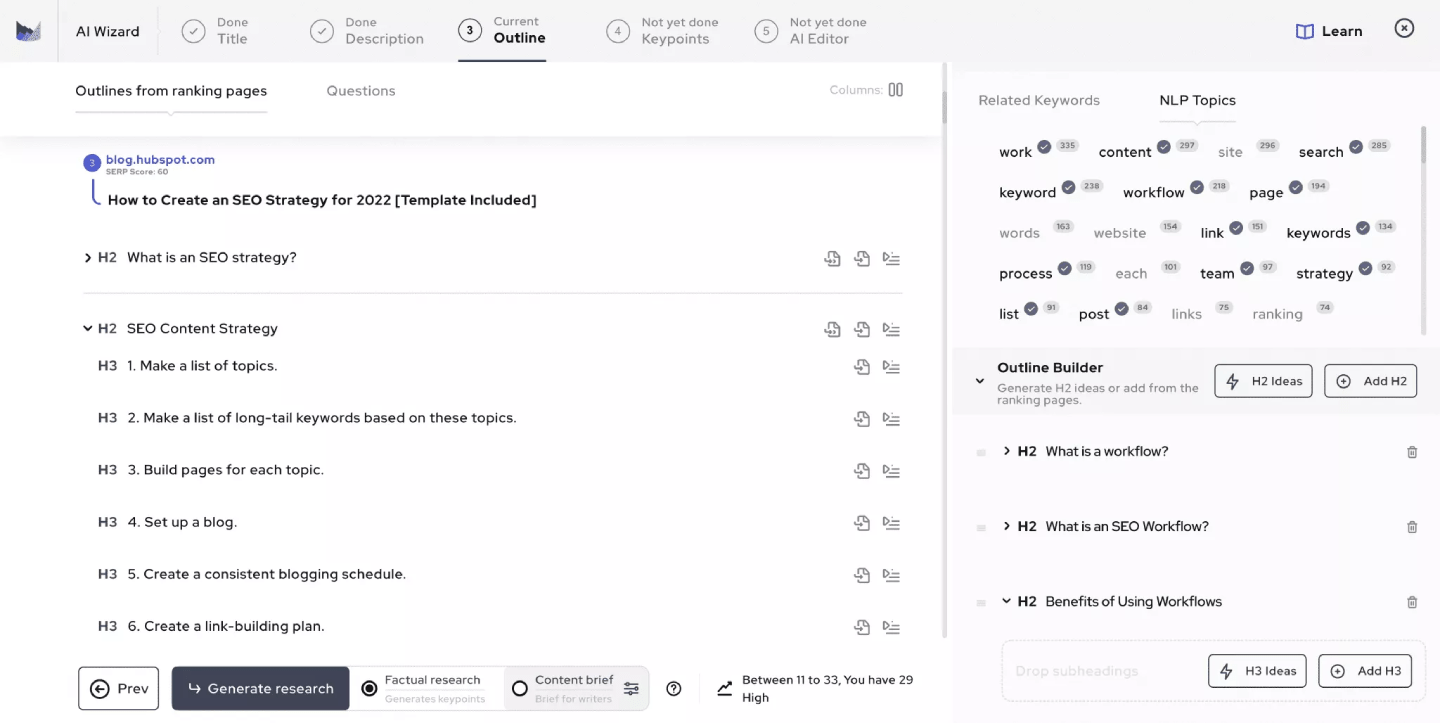
While Outranking’s interface can be pretty cluttered, you won’t struggle too much to understand what goes where. The process to take your content from keyword to finished article is also clearly outlined, so you know at all times what you have to do.
Their content optimizer is also much prettier than that of Frase IO. But in our book, it still doesn’t surpass Surfer SEO.
Pricing
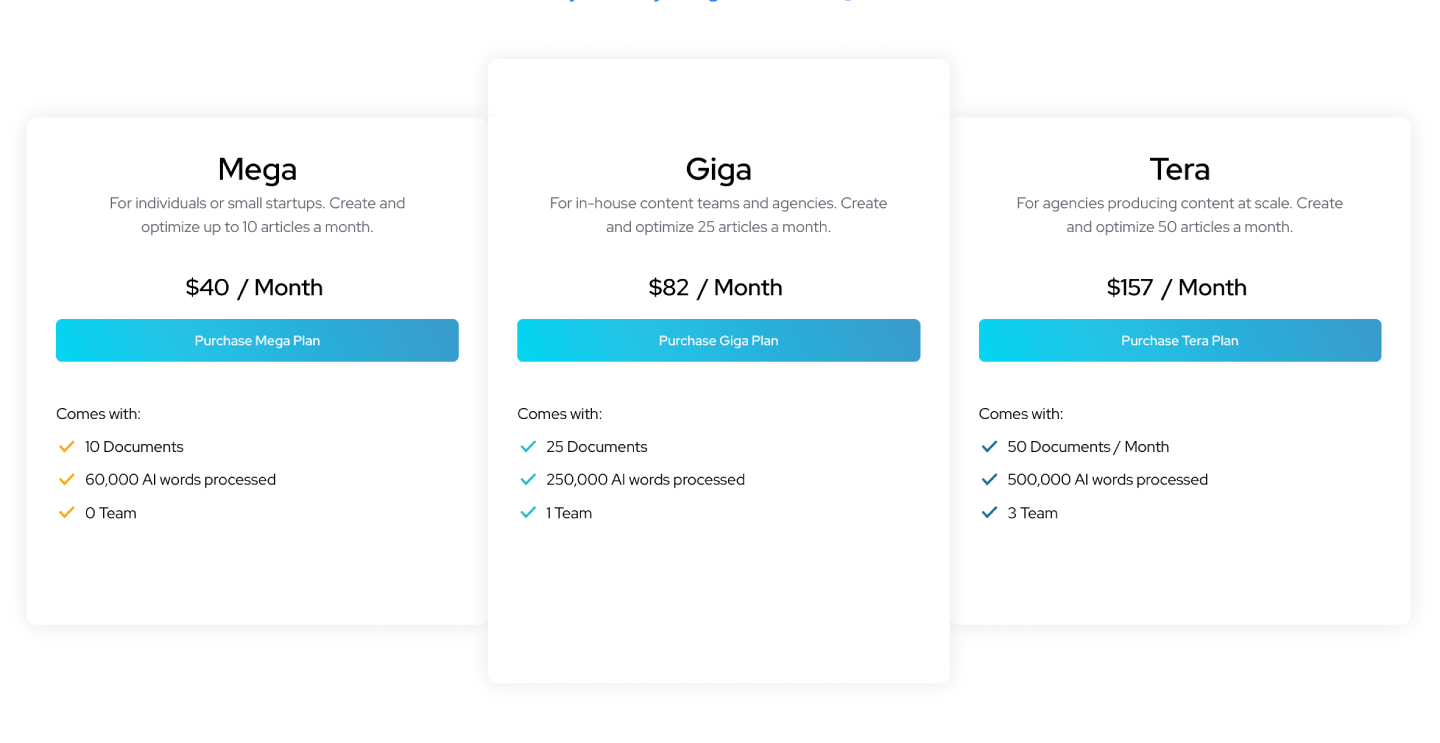
Outranking.io is pretty affordable. The best thing is that for the cheapest plan, you’ll get all the tools it has to offer. The only difference is in the content cap. And ten documents (60,000 words) for $40/month is a pretty good deal.
The closest thing to Outranking.io is Frase IO. And for that tool, you’ll pay a minimum of $75/month if you want all of its features. So Outranking has a pretty good deal.
Conclusion
Outranking.io’s research is not as comprehensive as what you’ll get from Frase IO. But Outranking is prettier, and more affordable.
So if you want an AI writing tool that can also help you research your articles, Outranking is a budget friendly choice.
You can get it today for just $40. Use OUTRANK50 code to get 50% off your first month.
12 Longshot AI

Fact-checking features
Some research capabilities
Robust AI writing skills
Limited interface customization
Little style and tone options
LongShot AI is your average AI content writing assistant, complete with templates and all the bells and whistles you’d expect.
On top of that, LongShot AI also has research capabilities.
And to stand out from the competition: a fact-checking system for the content they output.
Features
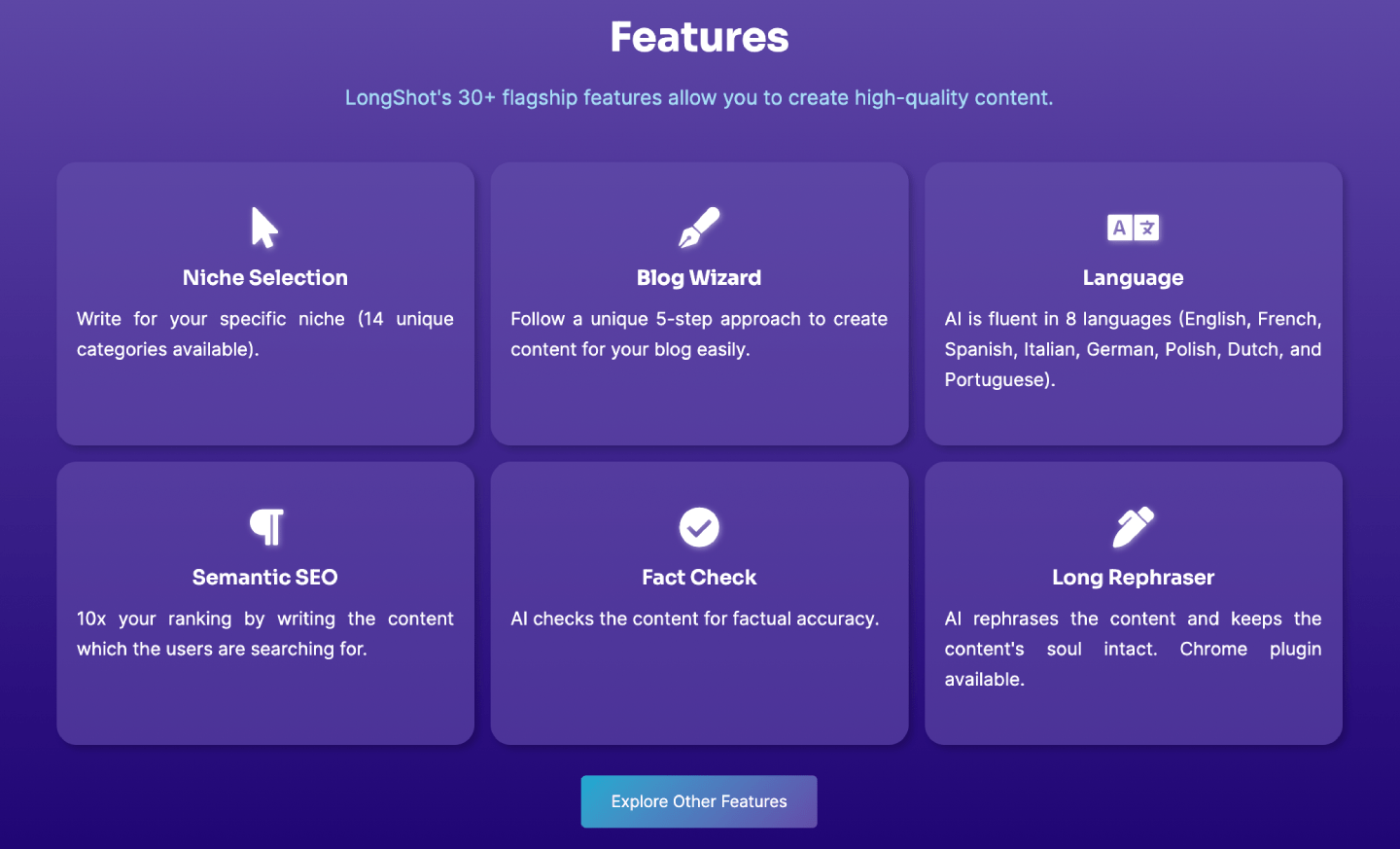
A big problem that AI writing tools face is that all the content they output needs to be fact-checked. A lot of times, what they write is… well, made up.
That’s the problem Longshot AI aims to solve.
Here are its main features:
Topic Research – Although it’s limited, Longshot can research a topic and suggest FAQs, or summarize the key points of a blog post.
Fact-Checking– Longshot will highlight potentially problematic claims in their content for you to analyze, and even fact-check an entire piece of text.
AI writing – Longshot is a pretty complex AI software. It has tons of templates, and quality of life tools to help you write faster.
Document editing – Rephrasing, summarizing, and explaining something simply, all help you improve content on page.
Interface and Ease Of Use
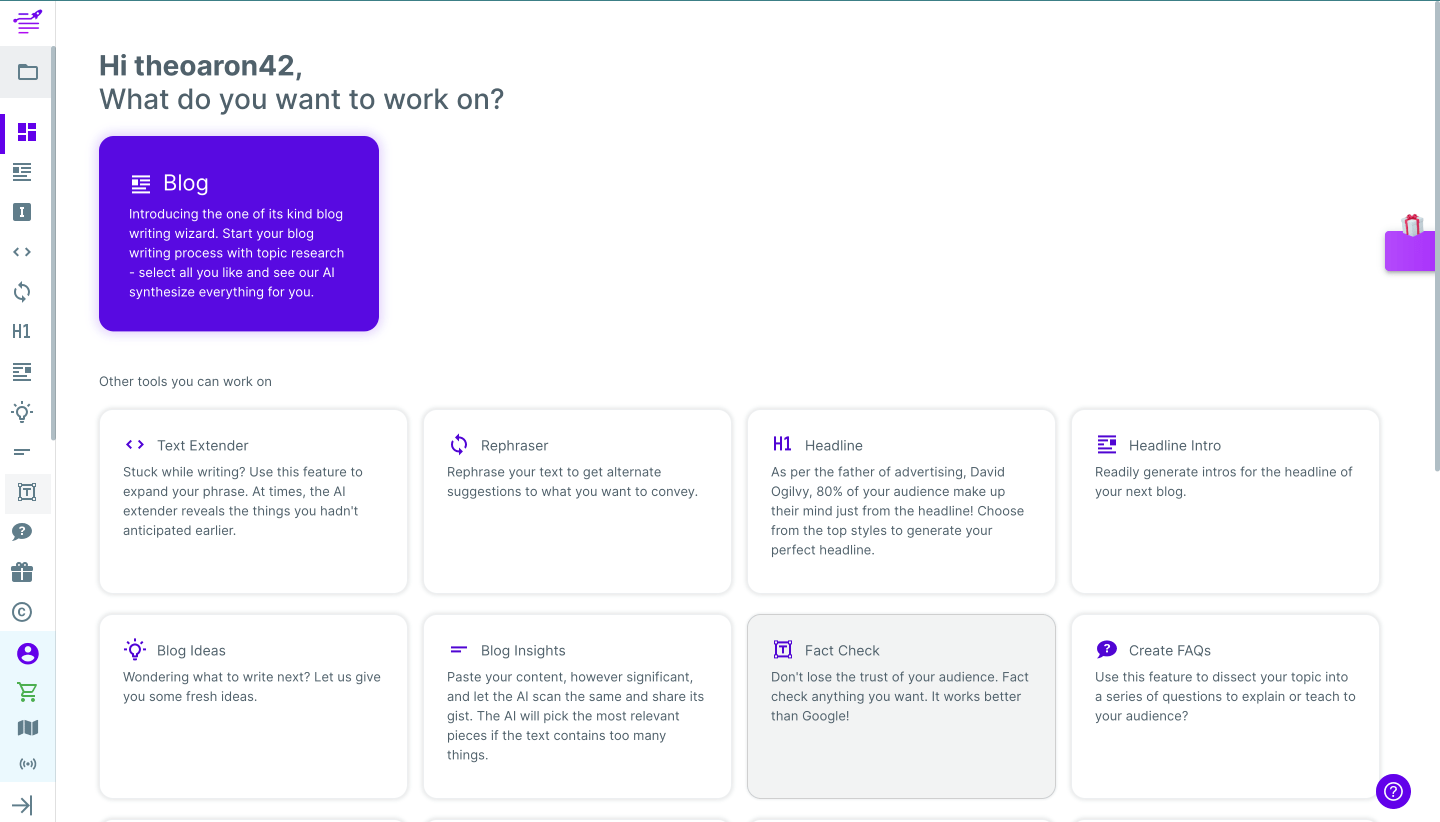
There’s not much to say about Longshot’s interface. It’s your average AI writing UX, and it does a good job introducing new users to its system.
Their fact-checking highlights also make it really easy to check a text for accuracy.
It even has a list of LSI keywords for the document you’re editing on the right side window.
Pricing
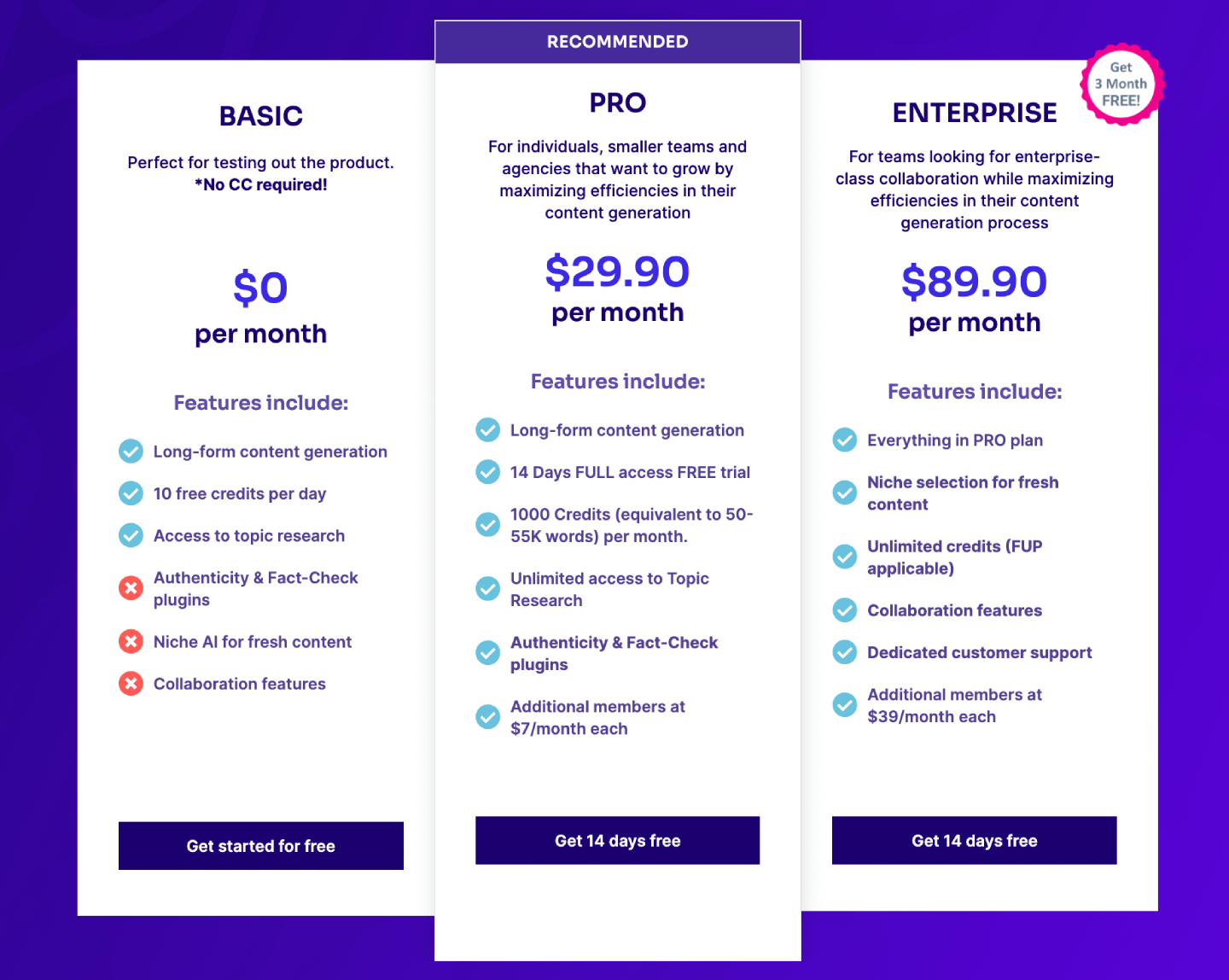
Longshot AI is pretty affordable. You’ll pay $29/month to unlock all of its features, and get about 50,000 words per month. That’s more than enough to cover your content needs.
If you want to try Longshot before committing to any plan, you can also use the basic subscription, which is free. But the word cap there won’t let you use it forever. And you can only try the AI generator, not the fact-checking system as well.
Lastly, you can also subscribe to the Enterprise plan if you need coworking features and dedicated customer support. But it will cost you $89/month.
Conclusion
If you want an affordable AI writer that can help you fact-check content, Longshot AI might be the pick for you. It’s a good web app, it has a very helpful toolset, and you can even edit documents directly like you would in Rytr.
If that sounds good to you, use our link try Longshot AI for free today:
13 Lyne AI

Great integrations
Impressive output quality
LinkedIn scraper
Hard to get started with
No customization options for content output
Lyne AI is an outreach too. It takes a prospect list (and even helps you scrape for one), and then generates AI content that you can use in emails for your leads.
Features
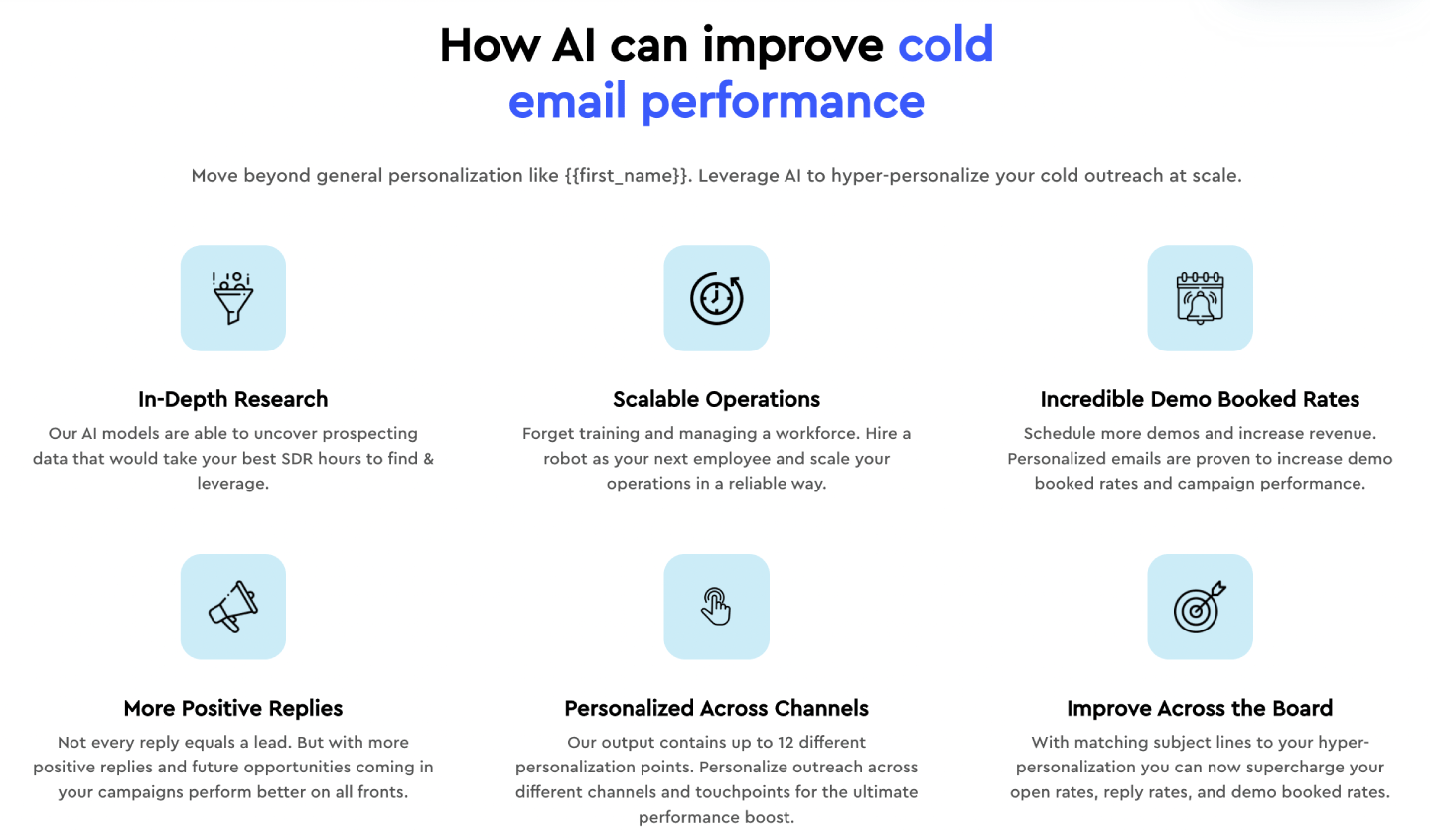
Whether you’re reaching out to potential talent on LinkedIn or sending dozens of cold emails every day, Lyne AI can help.
But it’s not your average AI writer. In fact, it works very differently than all the other entries on this list. It just creates suggestions for content to use in outreach messages — like ice breakers.
Let’s see how it works. Here are Lyne AI’s main features:
Advanced research – Lyne AI scrapes the web to find as much information about your leads as possible.
Fast Content Generation – While the initial writing can take a few minutes, it will generate content for dozens, if not hundreds of emails.
LinkedIn Scraper– Lyne integrates with the Sales Navigator to add LinkedIn contacts straight to Lyne lists.
Other integrations – Lyne integrates seamlessly into your sales stack.
Easy Data Imports – If you already have a list, you can get started with Lyne in a matter of minutes.
Interface and Ease Of Use

Lyne is a very well-designed app. Once you get used to it, you’ll love its shortcuts and the overall user experience. However, it can be confusing when you get started. Especially if you haven’t used a similar tool beforehand.
There is a demo of the app, yes. But it doesn’t do a good job of showing you what goes where.
Pricing
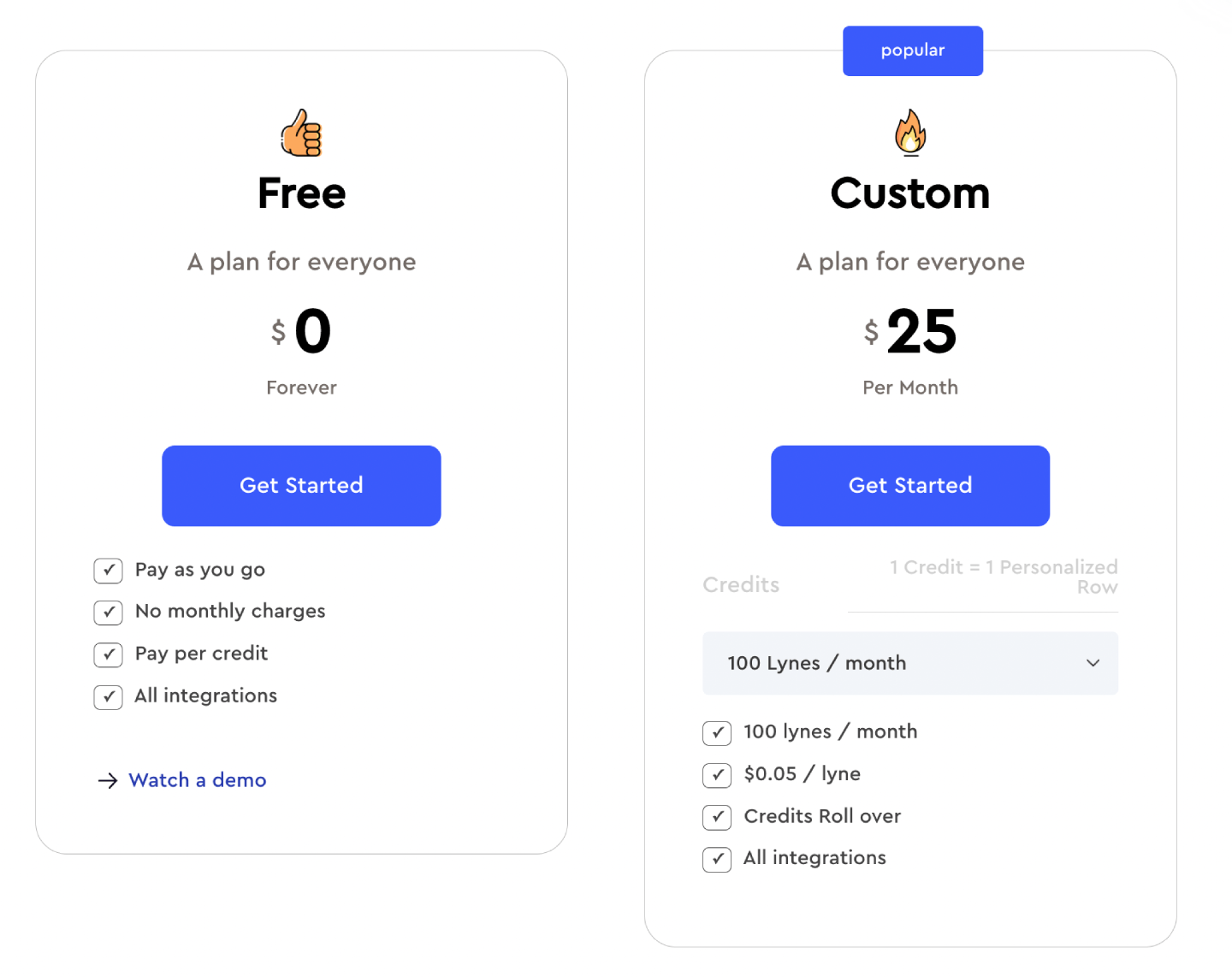
Lyne AI is very affordable, and it has a straightforward pricing scheme. You can try it for free, with only 25 credits (which translates to around 25 emails).
Or you can pay a minimum of $25/month to unlock more credits. Both plans also support a pay-as-you-go model. It’s a different pricing scheme from all the other entries on this list, but I think it works.
Conclusion
Lyne AI won’t write emails from start to finish. You’ll still need to edit its output. But it’s surprisingly good at kickstarting your sales and outreach copywriting processes. And it’s pretty affordable.
If that sounds good to you, try Lyne AI for free today:
14 Nyle AI

Fit for eCommerce businesses
A LOT of tools
Useful templates
Hard to get started with
Few style and tone options
Nyle AI doesn’t seem too special at first glance. It looks like a regular AI writer, with stock images plastered all over their website. But Nyle does have a clear purpose — all of its tools and templates are built to help eCommerce businesses.
If you have an online store and you want to write faster, stick around.
Features
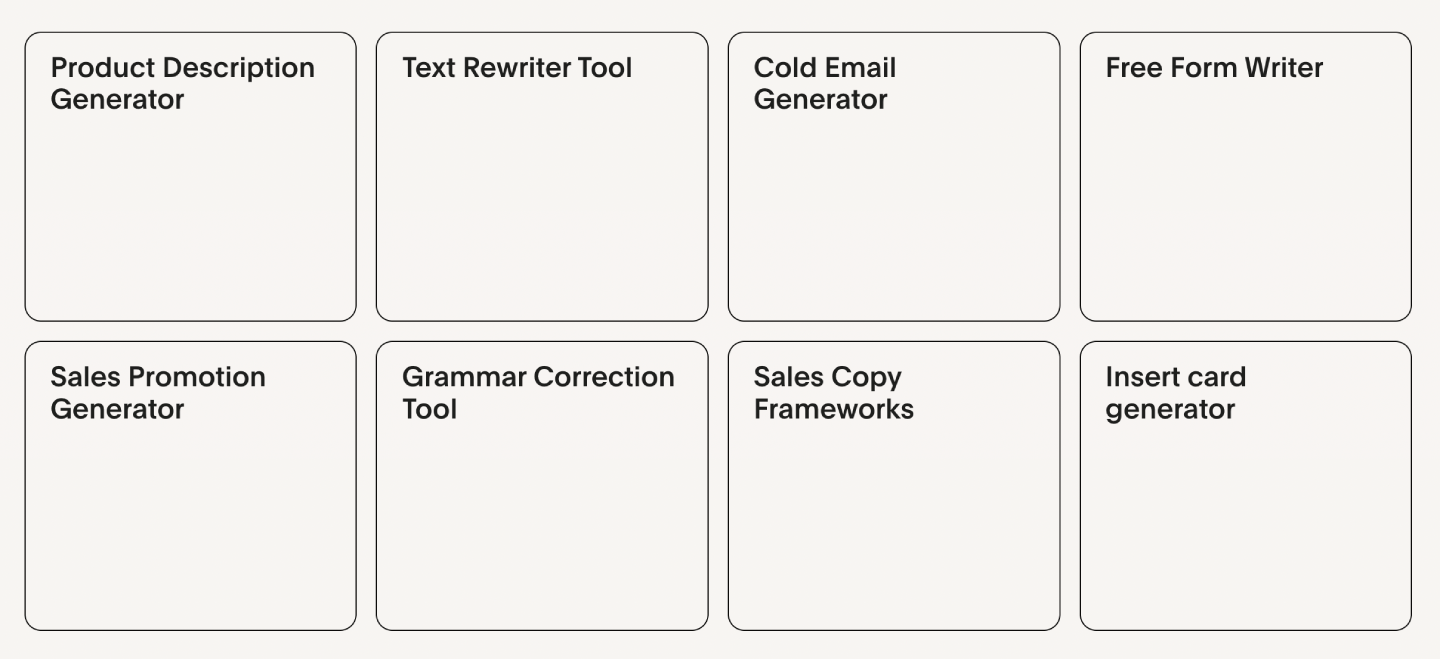
Nyle offers business development services as an upsell. But we won’t focus on that. For this roundup, we’ll only look at its AI tool, and what it can do.
Spoiler: it can do A LOT. Nyle’s toolset is stacked.
Here are Nyle AI’s main features:
AI Writing – Nyle AI uses GPT-3 to generate content for eCommerce site owners.
Over 15 short-form templates – That’s not a lot, but remember that all of them are focused on short-form copywriting for eCommerce.
Free Form Writer – Not quite as good as Jasper’s, but still helpful to build pages with the help of AI.
Image enhancer – Nyle AI can sharpen and enhance your images.
Influencer research – If you want to start a social media campaign, Nyle can help you connect with the right authority figures.
Keyword Tracker – You can track up to 1 million keywords, and automatically tune their PPC settings.
Interface and Ease Of Use
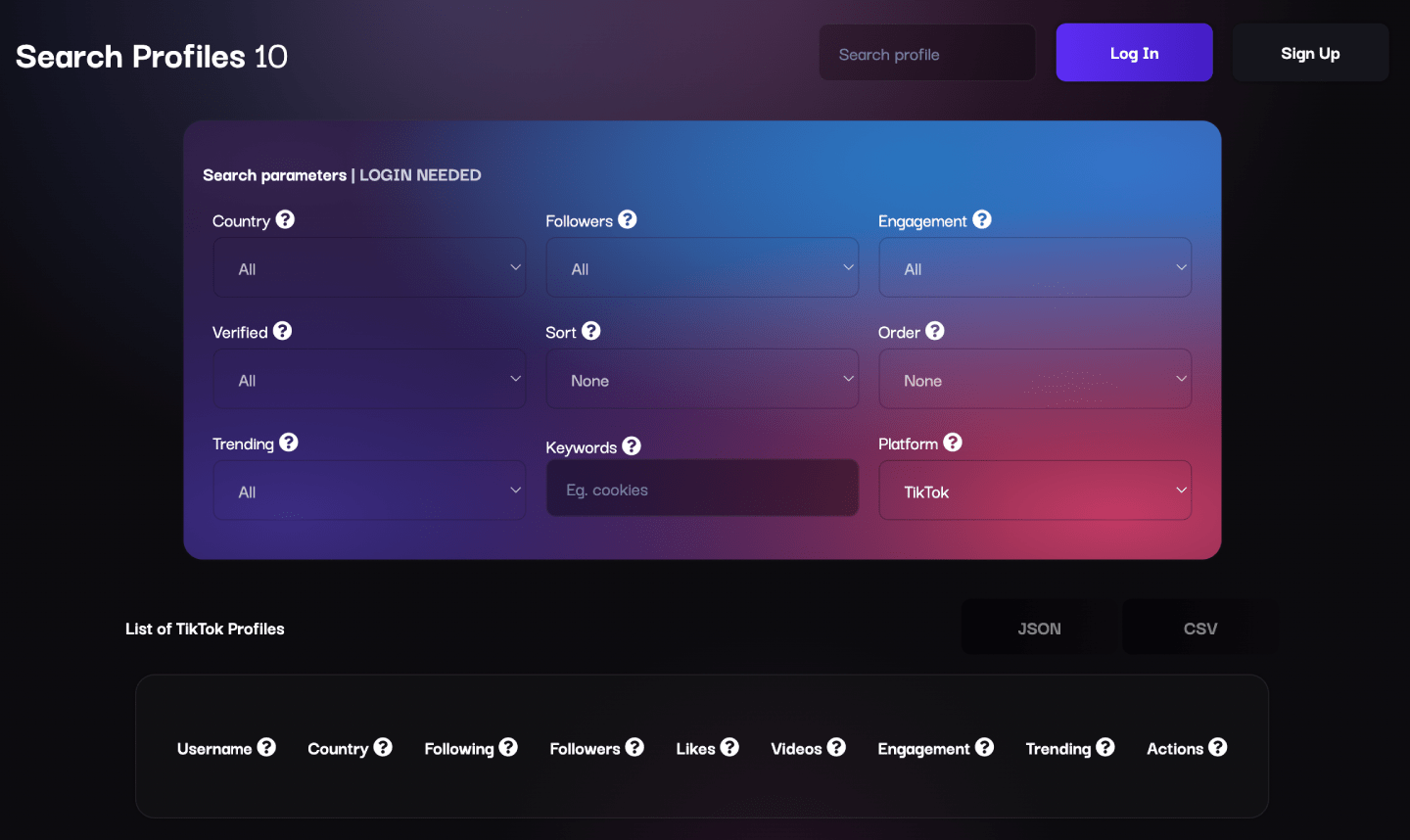
Nyle’s interface isn’t bad per se. It’s what you’d expect from an AI writer focused on eCommerce. The problem is that Nyle isn’t too easy to use. It’s a complex web app, and it can get confusing, especially for beginners.
But if you invest the time to learn its ins and outs, it’ll be worth it.
Pricing
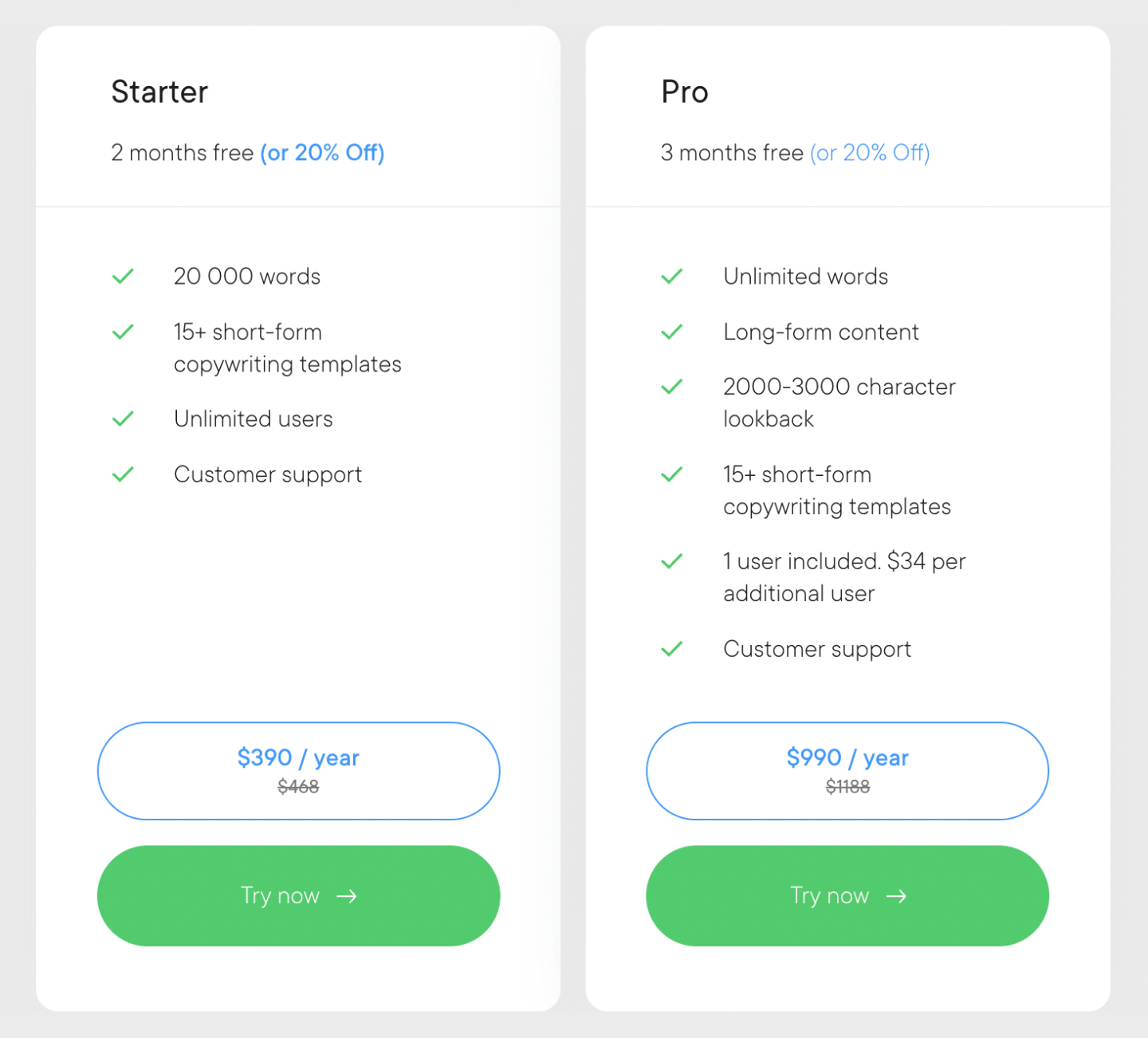
Nyle is slightly more expensive than your average AI writer. But I think its extra tools, and fine-tuned templates, make it a fair price for eCommerce businesses. If you pay for a full year in advance, you’ll spend $32.5/month.
However, the cheapest plan doesn’t have support for long-form, and it caps your content generation at 20,000 words. If you want to use Nyle AI hassle-free, you’ll need to buy the Pro plan, which is pricier.
Conclusion
If you run an eCommerce business (or if you write content for one), you might want to consider Nyle AI. Its templates and extra tools make it a really useful AI writer.
You might need to spend some time learning how to use the tool.
But once you get the hang of it, you’ll start reaping the rewards.
Try Nyle AI today for $32.5/month:
What Is The State Of AI Content Generation Today?
AI writing software can streamline your writing process.
Even with current technology, that’s undeniable. In most AI writing assistants, you can pick the AIDA template, describe your product, and get a decent snippet of copy built on the AIDA model
With some editing, you can use that snippet of content in your marketing efforts.
Most AI writing tools offer much more than just a single marketing template.
Most of them have dozens:
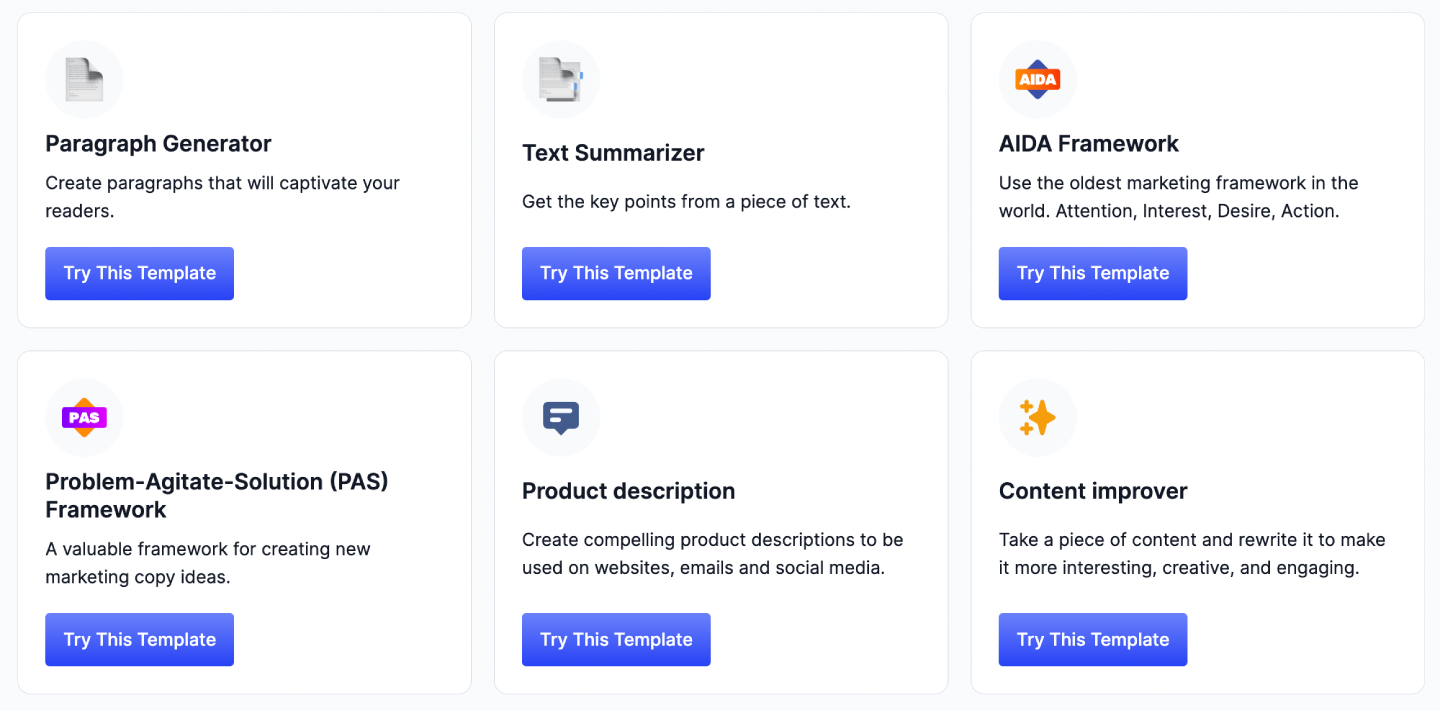
All of which can create general copy, product descriptions, social media posts, and everything in between.
So for that purpose, AI content generation can improve your processes, especially if you train the AI to understand your content (more on that in our Jasper AI review).
However, the current generation of AI writing tools (most of them based on GPT-3) has a long way to go before replacing human writers.
For starters, the content is often not factual. AI writing tools like to make stuff up. On top of that, you can also get buggy output.
And besides Jasper AI, most of the other tools on this list struggle with long-form content.
The final nail in the coffin?
Google discourages (and may penalize) content generated with the help of AI.
So that’s why, in my opinion, AI writing assistants have limited uses today. But they’re better than yesterday, and I’m hyped to see what the future holds for this niche.
Conclusion: How To Pick The Best AI Writing Software For You
Jasper AI is by far the best AI writing software.
So if you’re undecided, just pick Jasper. It’s a safe bet. And you get 10,000 free words with our link.
There are two main reasons you wouldn’t want Jasper AI, though: pricing and supported languages.
If Jasper’s Boss mode is too expensive for you, Rytr or Copy AI might be better options. (You can also check out our Jasper AI Alternatives and Jasper AI vs Copy AI).
If Jasper can’t generate content in the language you need, Rytr probably has you covered. If not, check the other entries above.
And lastly — pick any other tool from the list above if you like some of their other perks. For example, Frase IO is a wonderful choice if you want research and keyword optimization on top of AI content.
FAQ
What is the best AI writing tool?
What are AI content writing tools?
AI content writing tools use machine learning and artificial intelligence for content creation. They can imitate humans writing something with little input, but the quality of content creation in these apps can vary drastically from one project to another.
Is AI Writing free?
Most AI writing tools have a free version that people can use to try out artificial intelligence writing. But for all the features and unlimited credits to write content, you’ll probably have to buy the paid version of AI writing software.













